A New Beginning (1993 – Present)
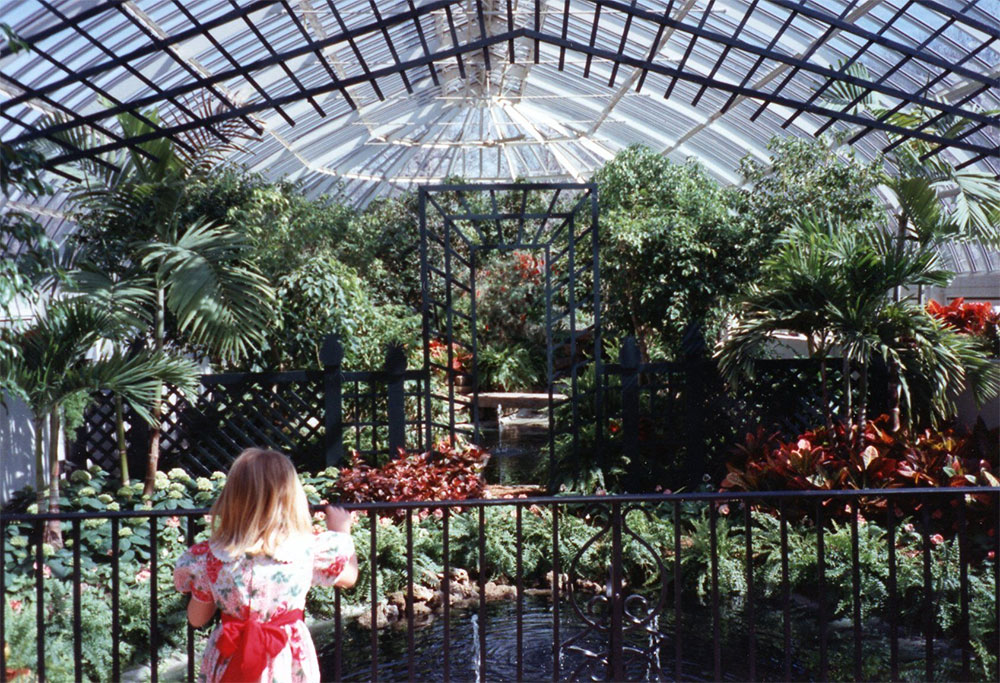
July 19, 1993 was a momentous day for Phipps Conservatory. The City of Pittsburgh and Phipps Friends, now known as Phipps Conservatory, Inc., signed a public-private lease agreement placing responsibility of the Conservatory upon Phipps Conservatory, Inc. As a new era of private management began; Director Gary Baranowski assuaged public doubts about the change: “We don’t want Phipps Conservatory to be a private club. We want it to be a place for people to come and enjoy. That’s what a partnership will allow us to achieve.”69
With the 1993 agreement in place, Horticulturist Curt Pesanka saw his opportunity to help restore Phipps into the beautiful and enjoyable destination that he had experienced in his youth. Pesanka worked with tropical plants in Florida at the time of the agreement signing, and as soon as the Conservatory became privately owned, he saw a chance to revitalize its horticultural displays. “I was excited because I grew up in lower Oakland and I used to come with my father early in spring for the shows. As soon as I read that it was no longer being city-run, I was one of the first applicants, and I was one the first horticulturists hired on,” says Pesanka, celebrating his 27th year at Phipps at the time of the interview. In August 1993, newly-hired Pesanka was placed in charge of the Victoria Room, East Room and Broderie Room in the east wing of the Conservatory.70
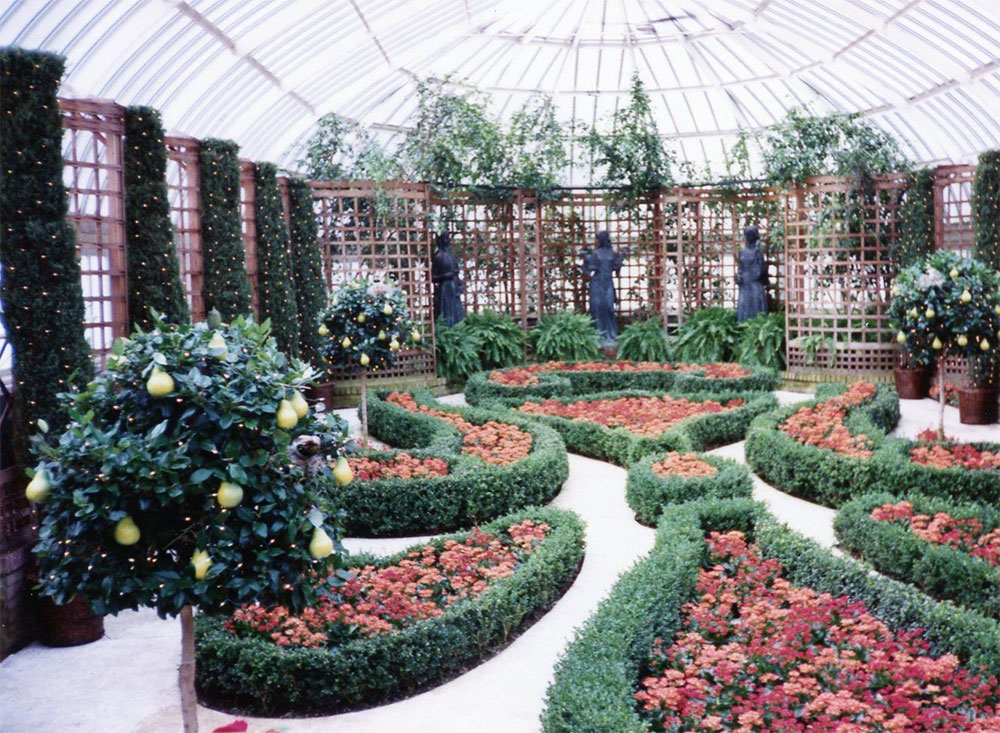
Renovations underway at the time of Pesanka’s hiring, plus Phipps’ small group of 26 staff and change in management, meant that Pesanka started with a long to-do list — especially with Fall and Winter Flower Shows immediately on the horizon. “We would work as a group to very quickly put together a design for a show that might be two months away and we were really urgently trying to come up with designs,” Pesanka says. He fondly remembers the early months of working with a small team of horticulturists in a changing Conservatory. “It was really great to see horticulturists come in and make drastic change in a short period of time. We wanted to prove to everyone that [Phipps Conservatory] made a [good] decision taking us on and that we knew what we were doing.”70
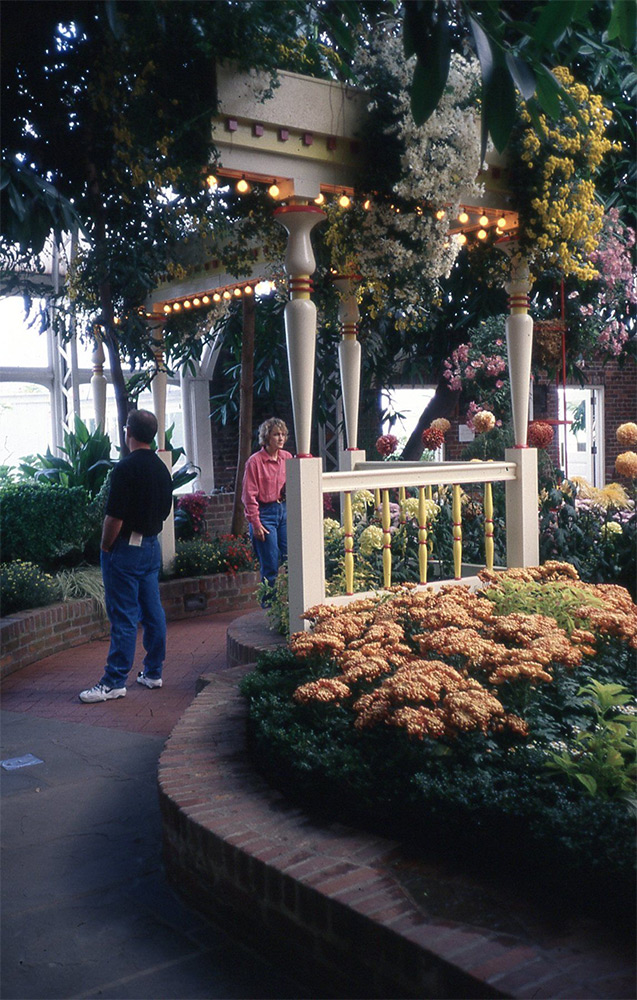
Joining Phipps turned out to be a good decision for both the organization and for Curt Pesanka. December 1993 saw the opening of a Winter Flower Show with newly repaired glasshouses and refreshed horticultural displays. The Pittsburgh Post-Gazette credited the clean and fresh new ambiance to the work of “14 full-time and several part-time staff and a band of dedicated volunteers.”113Joining Phipps turned out to be a good decision for both the organization and for Curt Pesanka. December 1993 saw the opening of a Winter Flower Show with newly repaired glasshouses and refreshed horticultural displays. The Pittsburgh Post-Gazette credited the clean and fresh new ambiance to the work of “14 full-time and several part-time staff and a band of dedicated volunteers.”71
The employment structure at Phipps continued to evolve soon after it changed to private management. In July 1994, the Board of Directors approved the hiring of the Conservatory’s first executive director: Richard V. Piacentini. A New York native, Piacentini had started his working life as a pharmacist until he rekindled his passion for plants in a bonsai class. He became interested in the National Arboretum and asked an employee there how he could eventually lead a public garden. When they advised getting a business degree, Piacentini changed course and earned master’s degrees in business administration and in botany. After tenures at the Rhododendron Species Foundation near Seattle, WA and the Leila Arboretum in Battle Creek, MI, Piacentini arrived at Phipps Conservatory.72
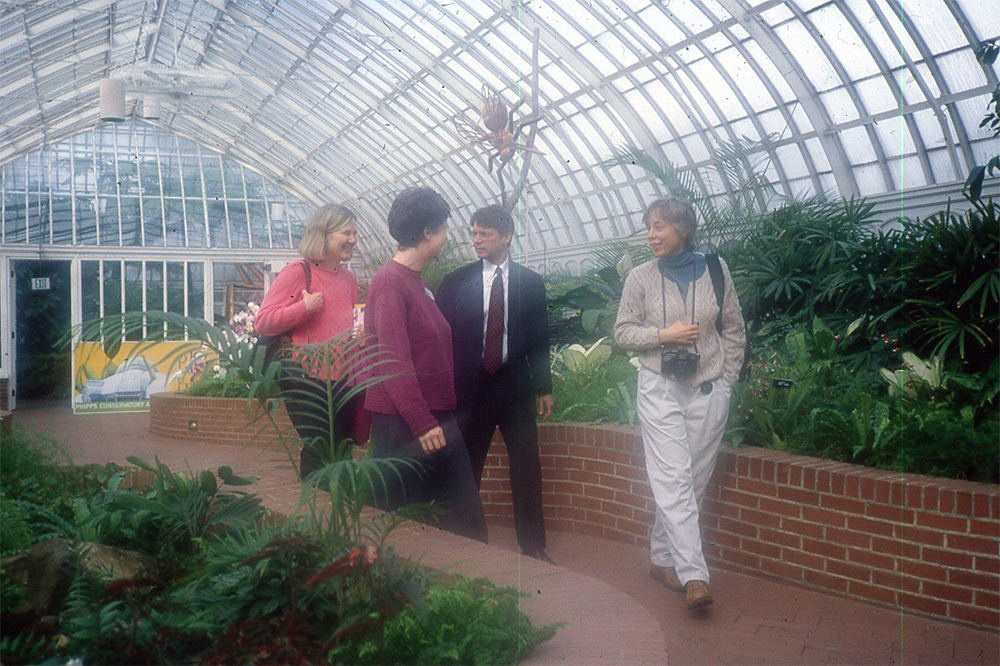
He hit the ground running with big ideas. “Visitors come for the different shows, but we want to stress coming any time because there is always something new to see,” he said. To this end, Richard Piacentini expressed his vision to expand educational programs, debut children’s programs and build a dedicated children’s area, increase the staff to at least 35 employees, and to ultimately “[go] back to founder Henry Phipps” and his idea for a place of pleasure and instruction.72
Piacentini’s ideas quickly materialized. July 1994 saw the debut of Phipps' Discovery Day programs for children from pre-school to age 10. The entrance was reorganized to better facilitate guest traffic flow by moving it to a side door location.
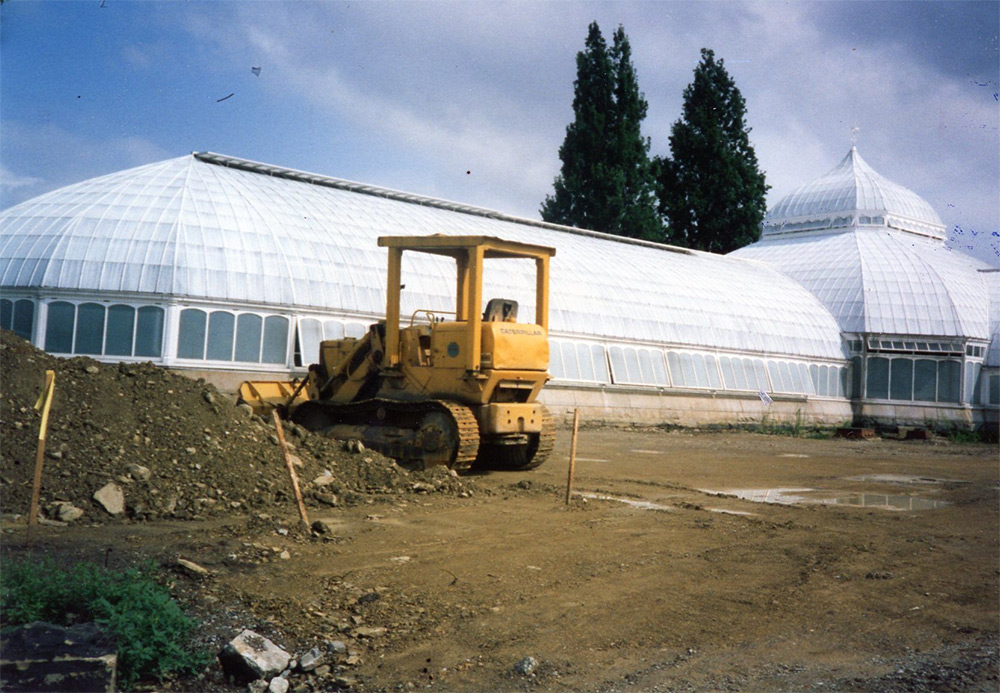
The Conservatory’s plant collection also quickly expanded. Piacentini brought his personal Japanese white pine collection and pre-bonsai collection to Phipps upon his hiring. In 1994, 40 palms were also donated to the Conservatory, of which two spindle palms and two foxtail palms can still be found in Palm Court today.72
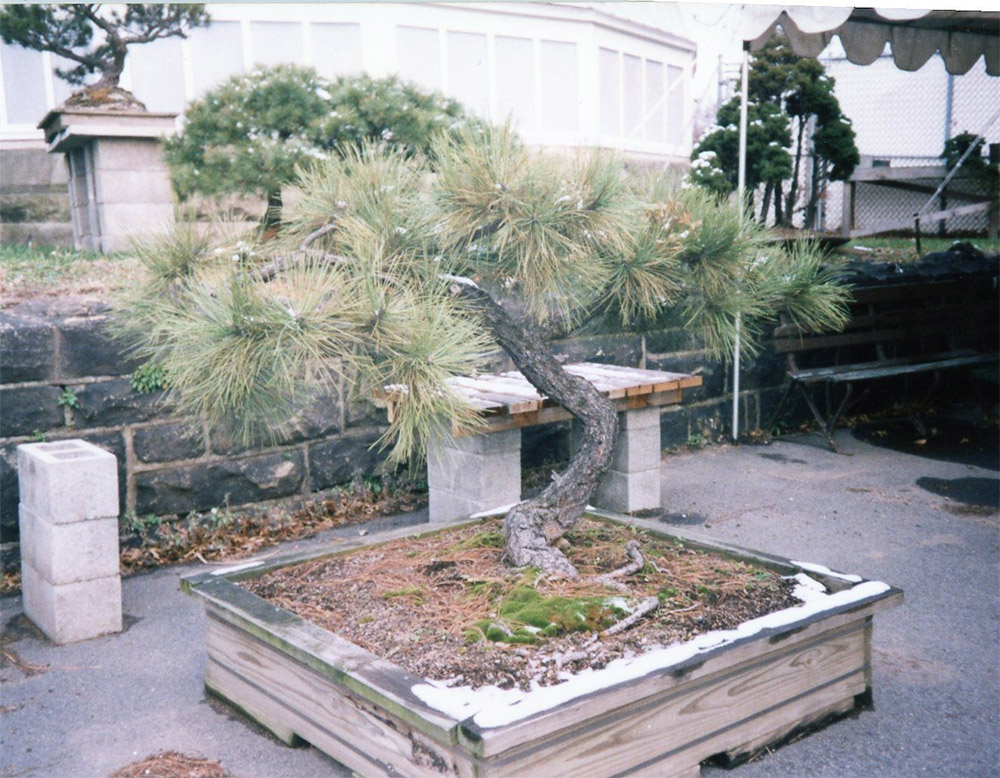
In late 1994, a joint Phipps-Carnegie bonsai exhibit opened in the Carnegie Museum of Natural History’s Sculpture Court, presenting the first exhibit of bonsai as art in a major American art museum. The exhibit ran for four months. Also during this time, an illuminated wooden façade was installed at the front entrance to the Conservatory in time for the opening of Winter Flower Show. The façade remains today, outlining the original Lord and Burnham Victorian design of the Conservatory.
Dec. 31, 1994 marked Phipps' first New Year’s Eve Celebration for families. This popular annual event continues today with entertainment, activity stations and a festive ball drop for children.
In 1995, construction began in several areas of the Conservatory. A new outdoor space dedicated for children materialized — the Children's Discovery Garden. Paving bricks were sold to help defray the cost of construction; engraved bricks remain available for sale today as a means for guests to remember a loved one, celebrate a family member or life event, or to treasure their own “piece” of Phipps. The historic Cottage Garden was reimagined into today’s Tropical Fruit and Spice Room, featuring flowering fruit trees and spice plants from around the world. The room was reconfigured with a door at the rear which leads to the Children's Discovery Garden.
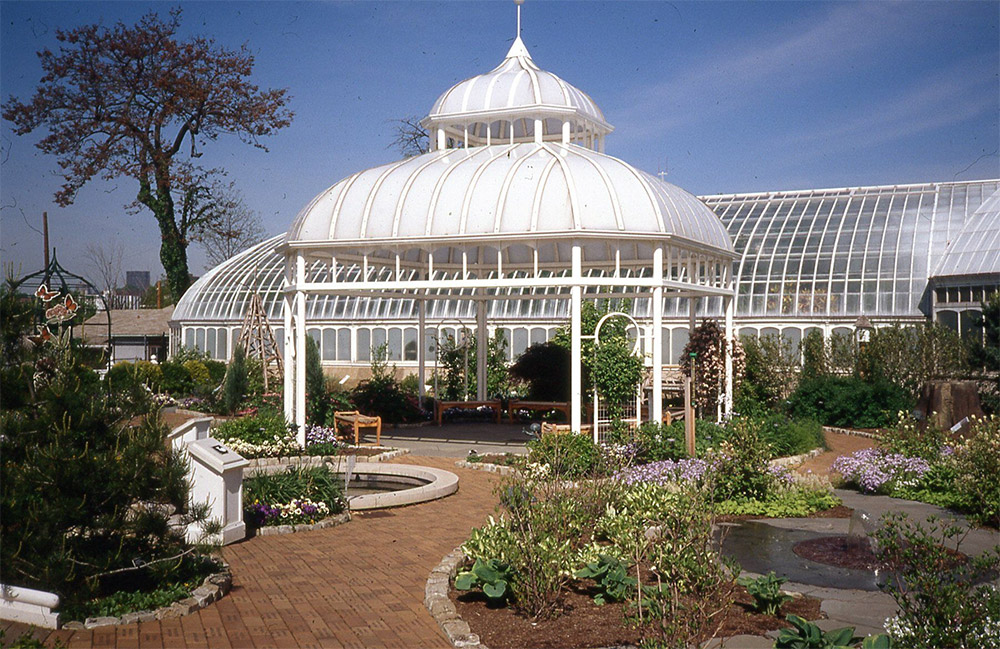
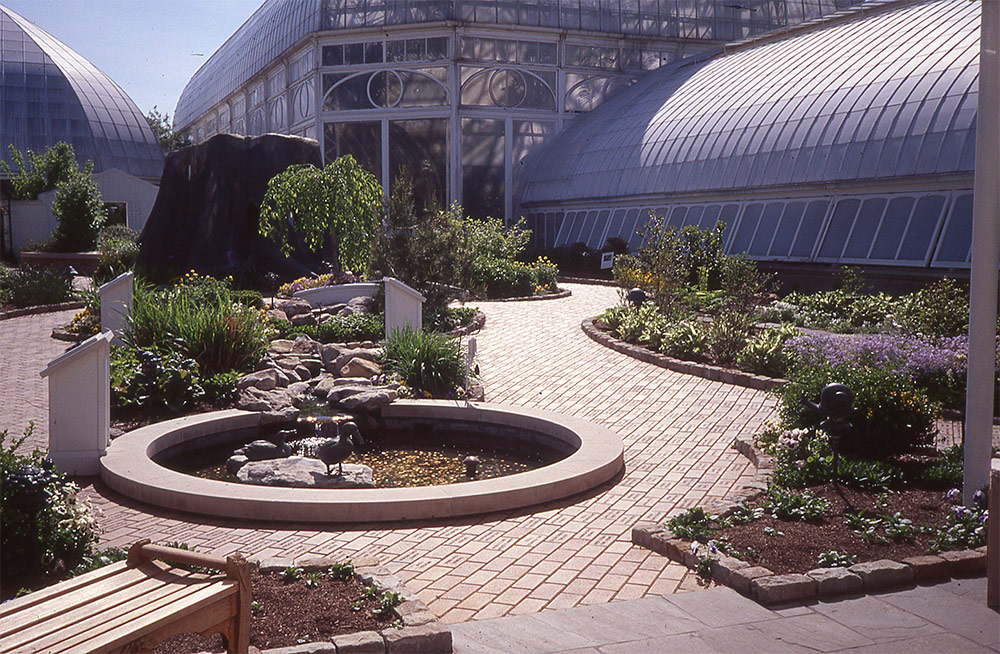
The Children's Discovery Garden opened on July 13, 1996 to great fanfare and two days of activity-filled celebrations highlighting fun features that are still present today, such as a giant climbable tree stump, a maze and a sensory garden.74 The spring opening of the seasonal Children's Discovery Garden remains an exciting annual event.
The Children's Discovery Garden complemented an exciting new education department at Phipps that was first led by Robert Alexander in August of 1995. The extensive program would facilitate learning opportunities for children through adults, individuals or families, including signs and brochures in the Conservatory.73
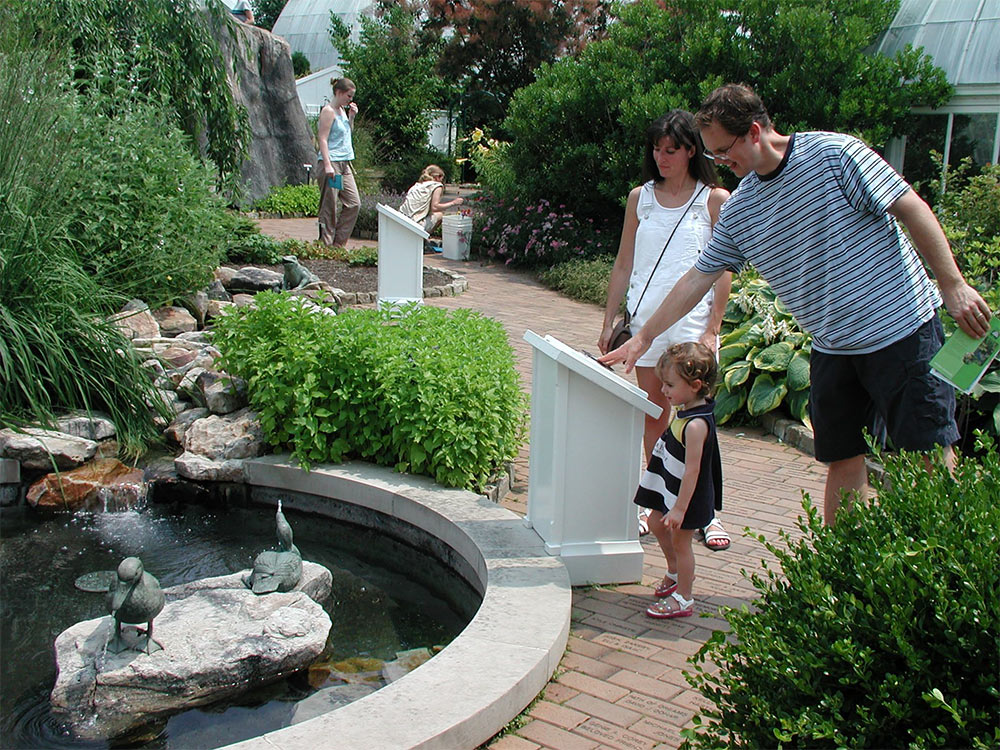
Also in 1996, a mythical figure made its return to Phipps after more than 100 years. A statue of Neptune, the Roman sea god, was gifted to the City of Pittsburgh in the late 1800s from Dollar Savings Bank. The city had chosen to install Neptune upon a circular pool at the Conservatory’s entrance from approximately 1894 – 1898. Neptune was restored and took up residence in the Aquatic Gardens on the east side of the Conservatory. His return to Phipps was financed with memorial funds from supporter Mary Reed Sutton, and a bronze plaque celebrating her memory can be seen at the Aquatic Gardens.
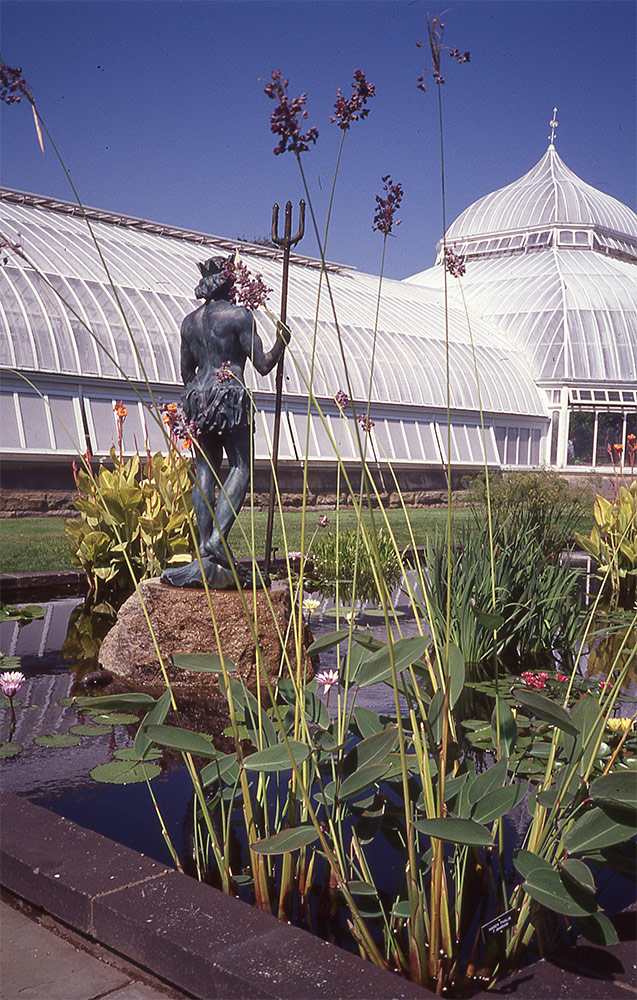
The late 1990s saw additional expansions of Phipps' relationship with guests and members. For the first time in 1996, the ongoing Phipps newsletter used the motto “Something’s Always Blooming at Phipps!” to encourage guests to visit time and again through the seasons. In 1997, the Butterfly Forest debuted in the Stove Room. It remains a popular summer attraction from mid-April through mid-September.
The year 1997 brought challenges as well as triumphs. In September, a new back-up boiler was installed in the greenhouse basement. Although the Conservatory was primarily heated by steam purchased from the Bellefield Steam Plant, the back-up boiler came through the very next month when, just before the opening of Fall Flower Show, a two-alarm fire damaged a Conservatory garage storing tools and materials and damaged the crucial steam line from the Bellefield Steam Plant.
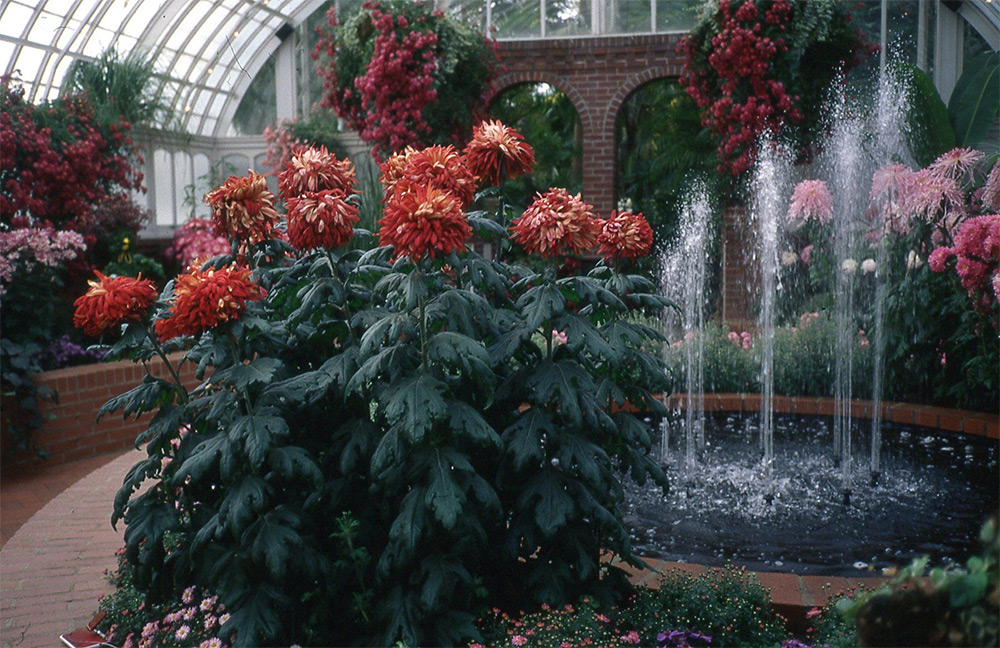
In March of 1998, Phipps announced expansion plans to include research and production facilities, a dedicated visitor center, a café and parking lot, a new rainforest display area, new greenhouses and expanded outdoor gardens. A $36 million capital campaign was initiated to fund the growth of Phipps from nine acres to 35 acres.
As market research progressed, however, Phipps saw a need to move forward with a strong emphasis on improving visitor services. Oakland was seen as a pivotal regional resource, and Phipps was poised to move its neighborhood further into the spotlight. As the nation’s third-largest Victorian glasshouse pre-expansion, the Conservatory had seen annual attendance grow from 110,000 at the beginning of the decade to 182,000 in 1998, with 20 percent of guests travelling from outside the Pittsburgh area to visit. The planned visitor facilities and Tropical Forest Conservatory would transform Phipps into an immersive and instructive year-round destination.75
To finalize the concept of this massive expansion, Phipps also announced our new name: Phipps Conservatory and Botanical Gardens. A new logo was designed for this renaming and appeared for the first time in the summer 1998 newsletter.
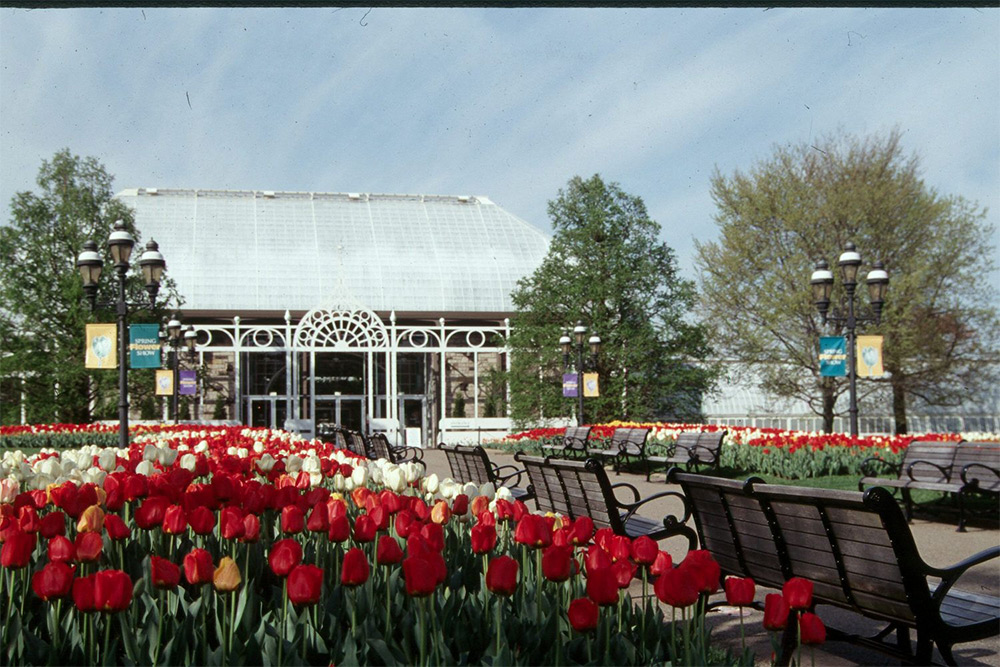
The Conservatory’s renowned bonsai collection grew in March 1998 when Bonsai Collection Curator Keith Scott sold 42 pieces from his personal collection to Phipps upon his retirement. The orchid collection also expanded in 1998 with the acquisition of the H. Parker Sharp collection of miniature orchids, which were a gift from the Parker estate. Many of these orchids are viewable today in the front of the Orchid Room where they are displayed in a specially built case.
In Spring 1998, an art collaboration of historic proportions appeared for the summer display; Diane Guest, granddaughter of Phipps Conservatory founder Henry Phipps, created an exhibit of animal flower sculptures to temporarily decorate her grandfather’s gardens.
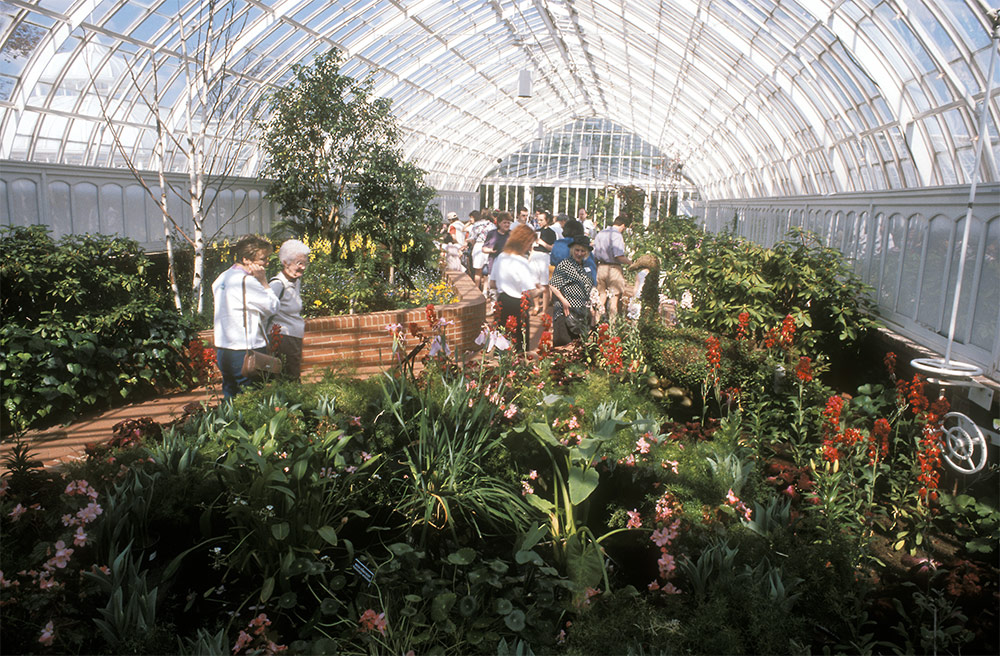
Phipps' campus grew in late 1998 when the Schenley Park Engineering and City Pool Office building was given to Phipps and renovated to create office space to be used by Phipps Friends. In September, the Phipps Hall of Botany underwent much-needed restorations when it was given to Phipps from the City of Pittsburgh. Botany Hall was ready for use again in January 1999.
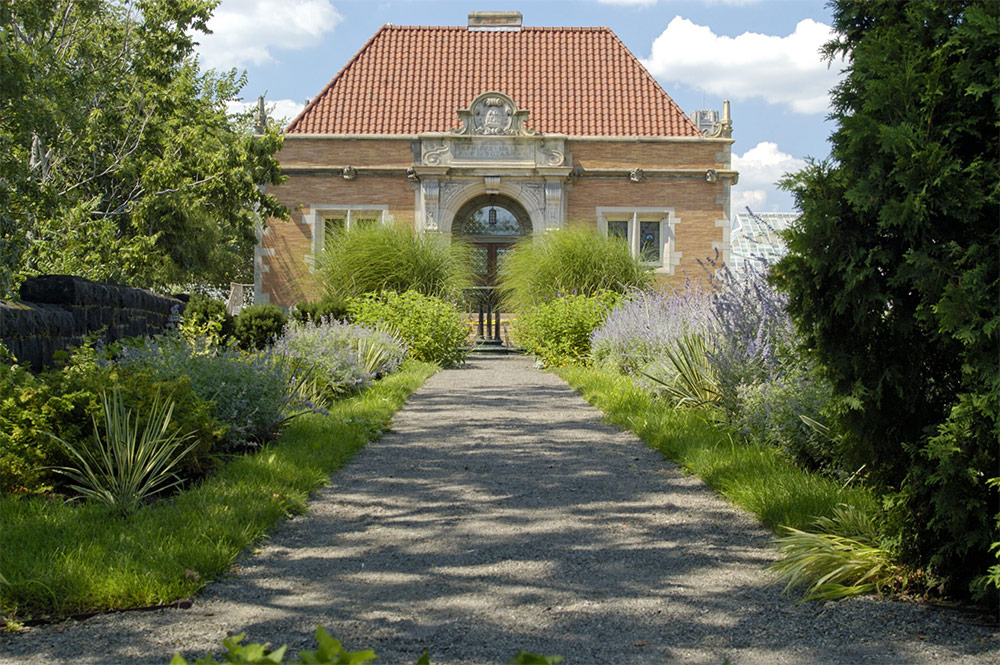
During the same year, the 14th Dalai Lama visited Pittsburgh for the first time, and a tree was dedicated in his honor in Phipps' Outdoor Garden.
By the end of 1998, Phipps Conservatory joined the modern era by creating a website. It was recognized in autumn of 1999 by the American Association of Botanical Gardens and Arboreta with an honorable mention for web page development.
The Conservatory bolstered the connection between people and nature in April 1999 by launching the Flora Awards program. Flora Awards were presented by Phipps to national and regional individuals who demonstrate a commitment to the beautification, education and advancement of the environment.
In October 1999, the first Phipps Garden Railroad debuted with the opening of Fall Flower Show. The G-scale railroad showcase appeared in the South Conservatory and operated through the end of February. The Garden Railroad was an enormous success and remains an exciting interactive exhibit that families enjoy every year.
In 2000, Botany in Action, a program originated by the Garden Club of Allegheny County dedicated to habitat research, conservation and education, was turned over to Phipps. The Conservatory gained the responsibility of providing grants to graduate students doing botanical field research and remains active today.
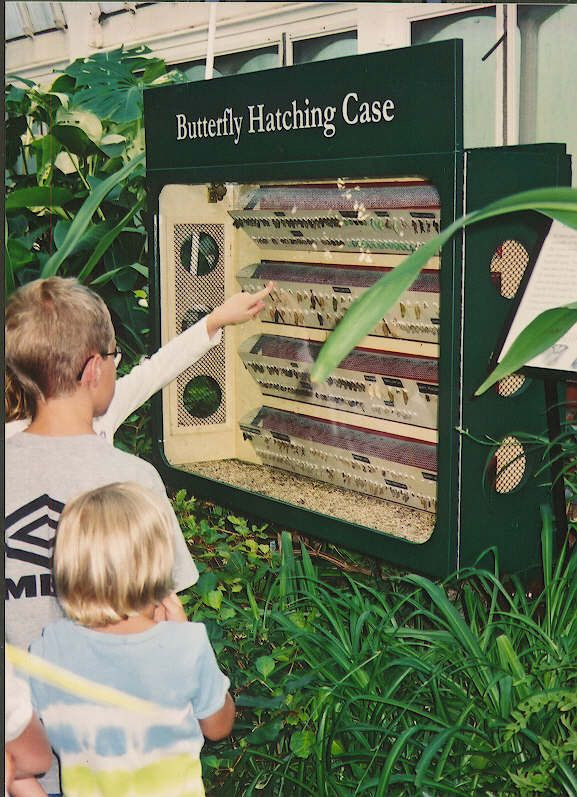
In February of 2000, Phipps took control of management of the admissions area of the lobby and the gift shop; these areas had previously been contracted out since the 1994 remodeling of the lobby.
A new chapter in Phipps’ education history began in January 2001 when Phipps merged with Pittsburgh Garden Place, formerly known as The Pittsburgh Civic Garden Center. The Garden Center is a horticulture education center established in 1935 and has been located in Mellon Park in a refurbished carriage house since June 1948. Today, Phipps Garden Center operates as an office building for administrative Phipps staff, a center for adult education courses, a rental site and more.
Director of Horticulture and Education Margie Radebaugh had worked at the Garden Center for over 12 years as its director of horticulture and education before the merger. She was excited to join the Phipps team. "My title when we merged was head of education. We all came to Phipps Conservatory and worked in different capacities," says Margie. "I at that point oversaw the high school intern program and volunteers. Phipps treated everybody well when we moved over. It was a good experience, and for me, working at Phipps was kind of a dream come true. It’s a premier horticulture place. Once you know horticulture, you think, ‘Wow, wouldn’t that be cool to work there?’"
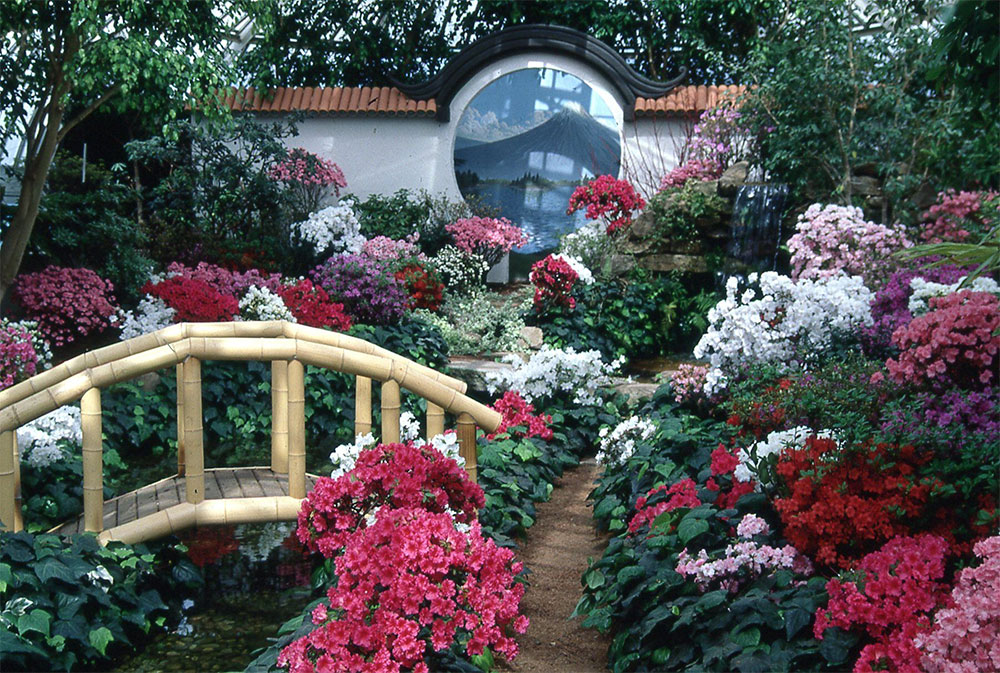
Radebaugh remembers the merger as a busy time with lots of change. All 13 staff from the Garden Center transferred to Phipps Conservatory. Radebaugh’s position changed to head of education, as Phipps already had a director of horticulture at the time. Many of the Garden Center’s programs — including school programs for young students, master gardener certification courses and volunteer coordination — joined Phipps’ school programs and tours. “It was a good combination that brought the two programs together, the strength of the school programs and the tours with the adult education,” Radebaugh recalls.76
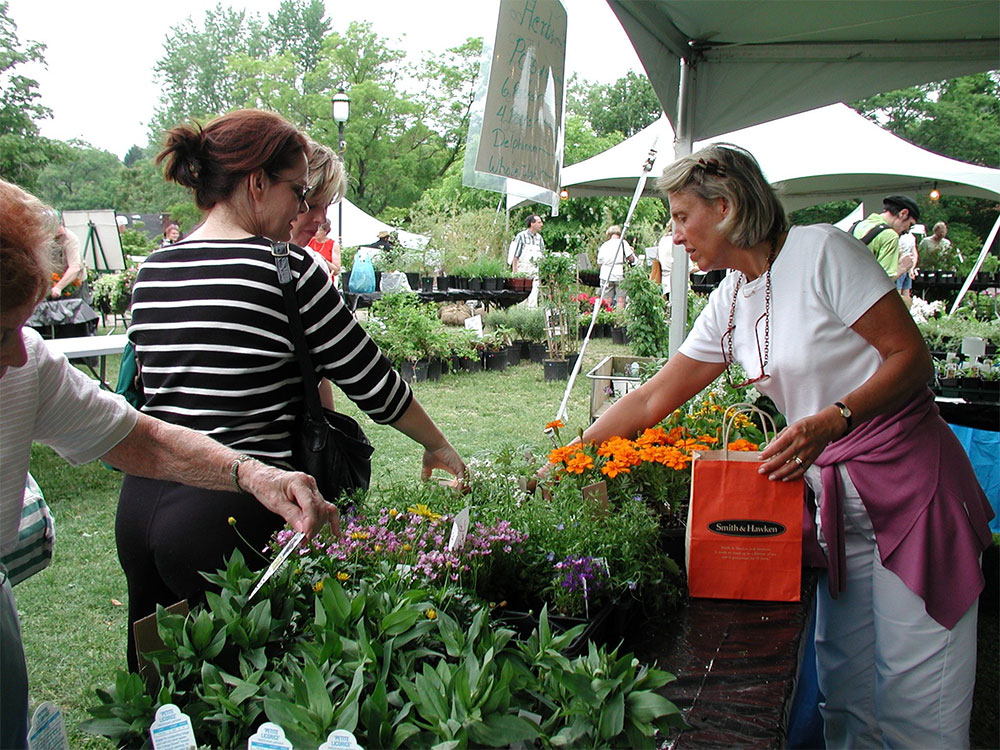
Combining programs led to a few exceptionally busy weeks during the year of the merge. “Phipps always had a plant sale which was Mother’s Day weekend. The Garden Center had the [plant] auction and then May Market. The first year we merged, we did the auction one week, the next weekend we did the plant sale and the third weekend we did May Market.” But as a Penn State graduate with a degree in horticulture, Margie Radebaugh was excited to return to her roots when Phipps named her director of horticulture and education several years later. “Being a part of the shows – it’s like Christmas morning. There’s all this preparation, and then it opens,”76 Margie says.
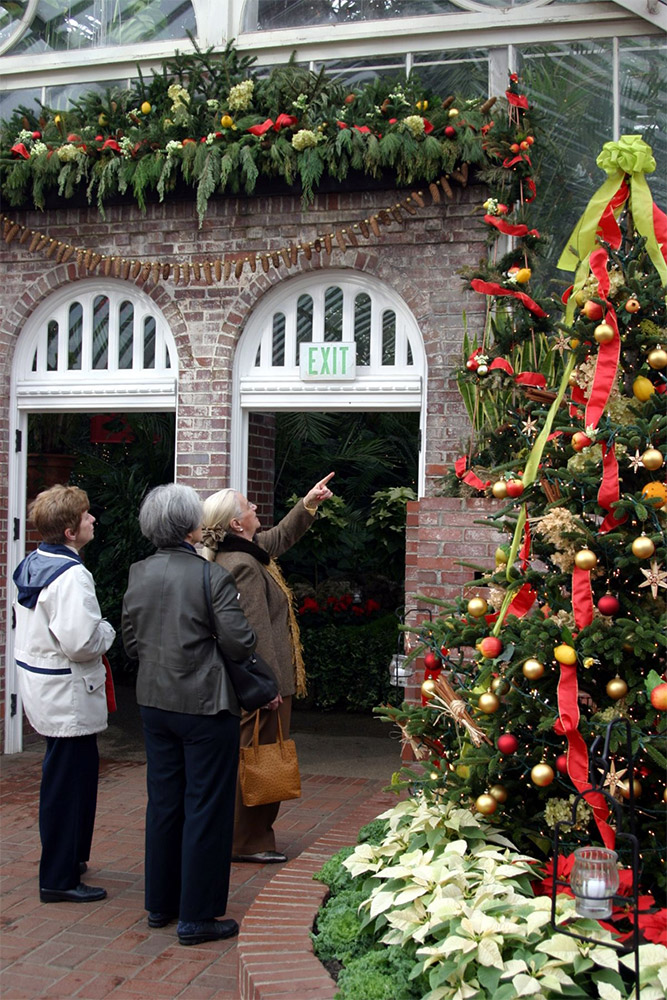
Phipps continued to collaborate with Pittsburgh-area organizations and improve our relationship with guests in the early 2000s. In 2002, Phipps partnered with the Pittsburgh Zoo & PPG Aquarium and the National Aviary to present a Victorian garden display at the Cleveland Botanical Garden Flower Show, to promote Pittsburgh as a family-friendly destination.
In 2005, exciting new facilities opened at Phipps, marking the beginning of the green building revolution to come. The state-of-the-art Welcome Center opened to the public. The lobby was built into the ground so as to compliment the view of the historic original glasshouses and the vistas overlooking Schenley Park, and was topped with a glass dome reminiscent of the Victorian-style Conservatory. The use of locally sourced building materials and an energy efficient design including water conservation earned the new Welcome Center a LEED (Leadership in Energy and Environmental Design) Silver certification. Housed in the Welcome Center are Café Phipps and The Shop at Phipps. Café Phipps features organic, healthy meals often sourced locally and from Phipps’ own Rooftop Edible Garden, served with recyclable and compostable products. The Shop at Phipps, an expanded admissions area and guest restrooms completed this improved facility, along with a dramatic curved staircase and two elevators that lead visitors up to the gardens.
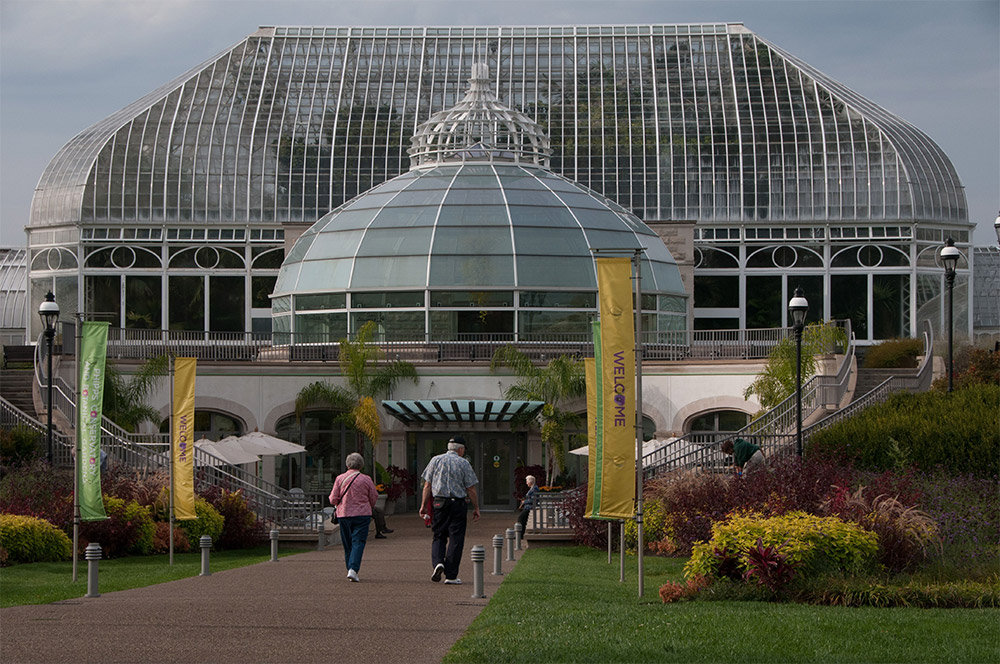
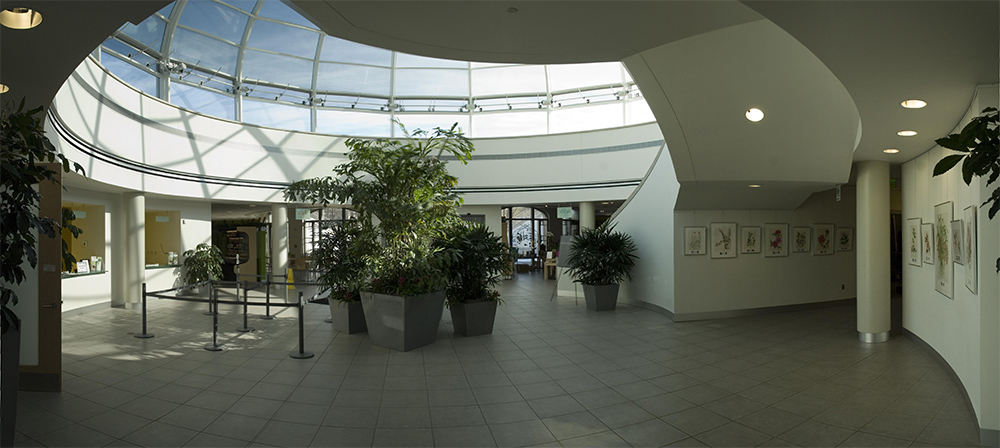
Also during 2005, a new Production Greenhouse was built behind the Conservatory, providing 36,000 square feet for horticulturists to grow display plants and store prized collections. In 2012, the greenhouses would become the first in the world to achieve LEED® Platinum for Existing Buildings: Operations and Maintenance, and one of approximately 20 buildings across the globe to reach the Platinum level. In this energy-efficient work space, the temperature, light levels and humidity are all computer-controlled, allowing the production staff to maintain 16 different climate-controlled environments within eight ranges and enabling Phipps to grow a wider variety of plants than was ever possible before. The Greenhouse also uses thermal blankets and roof vents, which regulate temperatures efficiently enough to reduce the need for fan ventilation and to reduce energy use.
Former Head of Horticulture Gary Baranowski reflected upon these sustainability-focused facility upgrades in a 2011 interview: “Horticulture is the original green industry…. I have a real appreciation for how Phipps has moved forward on issues of sustainability. I think under Richard’s direction, [Phipps] has accomplished some amazing things.”66
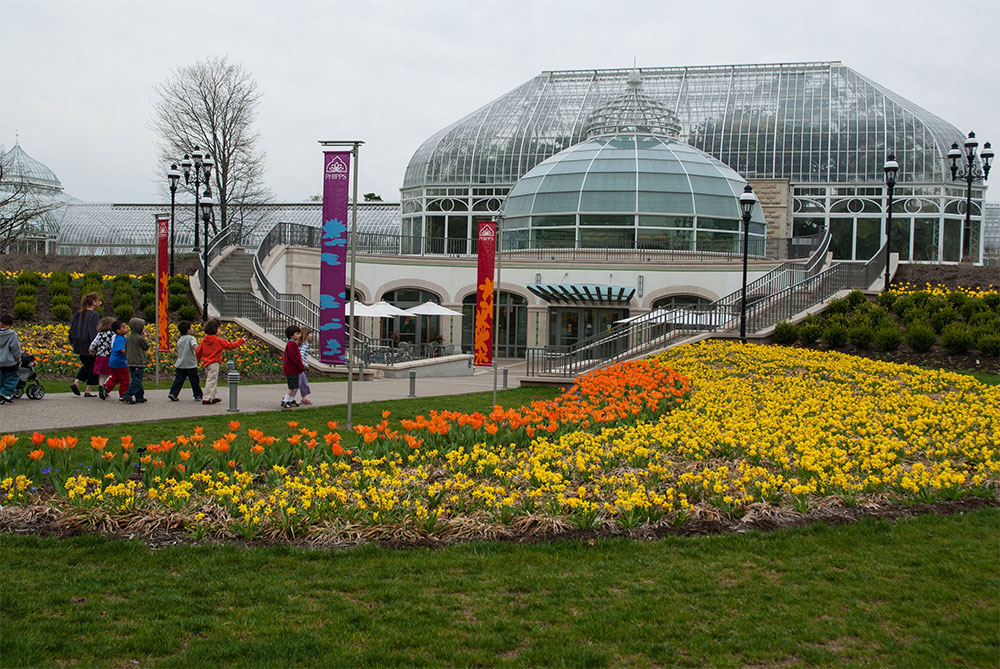
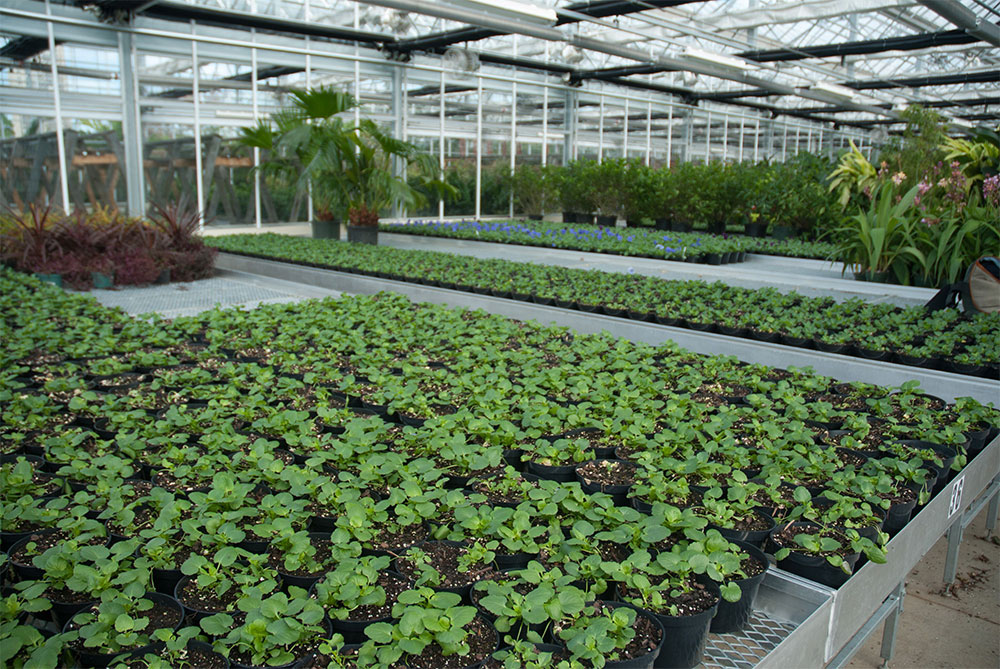
In December 2006, the new Tropical Forest Conservatory opened, featuring a two-year display of the flora and culture of Thailand. Celebrated as the most energy-efficient structure of its kind when it opened, the impressive 60-foot-high, 12,000-square-foot Tropical Forest Conservatory takes visitors from Pittsburgh and beyond on a colorful and inspiring journey through some of the most botanically rich regions of the world.
Incorporating impactful ethnobotanic displays, cascading waterfalls and lush greenery, this state-of-the-art facility was intended to raise the bar for glasshouse design and construction, further proving how favoring a fresh approach over past conventions can provide solutions to nearly any sustainability challenge — in this case, eliminating many of the high costs associated with heating and cooling.
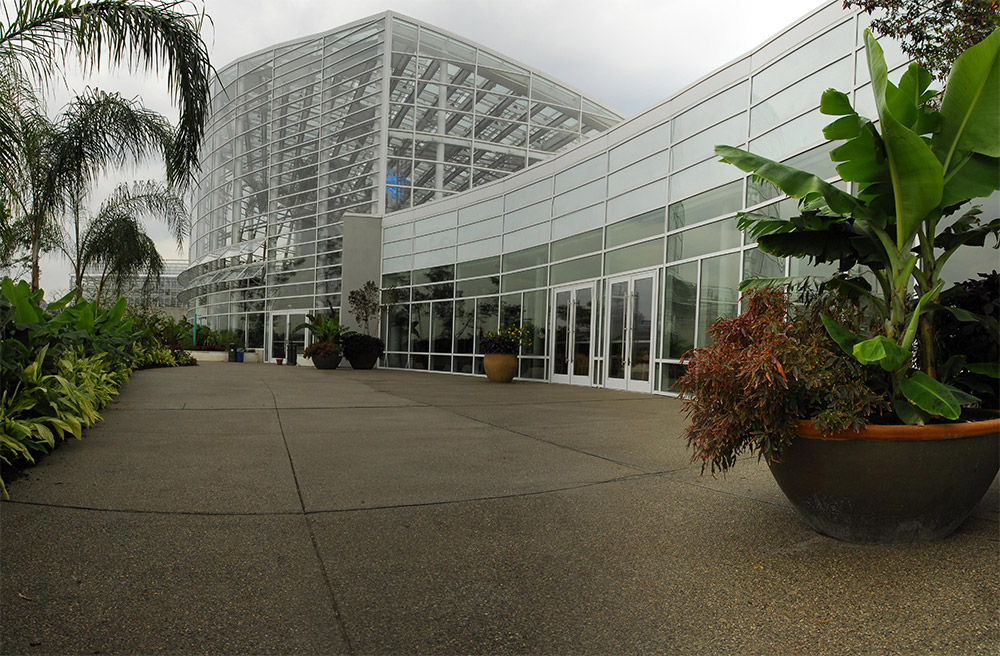
Earth tubes beneath the room bring cool air into the rainforest atmosphere, while roof vents use the natural circulation of wind to extract warm air from the humid room; shading and special glass help to cool the Tropical Forest Conservatory in the warmer months and conserve energy. It uses 40 percent less energy than traditional glasshouses, as it maintains more consistent temperatures year round, and uses practically no electricity thanks to its unique shape and a number of other energy-saving strategies.
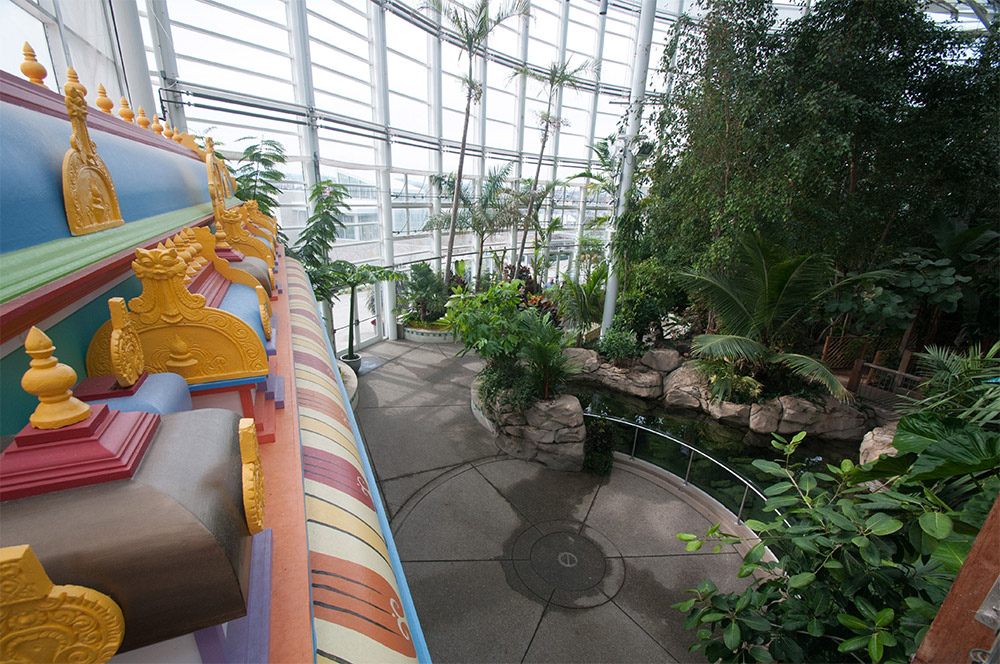
Executive Director Richard Piacentini explained the necessity behind Phipps’ evolution in energy usage: “If we say we care about the environment, we can’t just keep building buildings as we always have.”77 The new area was built adjacent to a new 12,000-square-foot rental facility called Special Events Hall, which accommodates up to 200 guests and opens onto a terrace overlooking nearby Schenley Park.
In May 2007, one of Phipps' most highly attended exhibits premiered: Chihuly at Phipps: Gardens and Glass. Glass sculptures by artist Dale Chihuly were integrated seamlessly into the glasshouses, presenting a surreal and intricately crafted symbiosis of plants and sculptures. Phipps worked with Chihuly to forego other institutions’ placement of the glass sculpture on pedestals, and to instead mindfully immerse the artwork among complimentary plants for a multisensory art experience. Because the Conservatory was accustomed to staging seasonal displays, Dale Chihuly worked effectively with Phipps exhibit designers and horticulturists to personally select plants to showcase with his art.78 Chihuly at Phipps attracted more than 400,000 visitors travelling from every state and from 52 unique countries; timed ticketing was implemented for the first time in order to condense overwhelming visitor interest into one organized flow of guest traffic. After the exhibit closed in February 2008, several pieces found permanent homes at Phipps.79
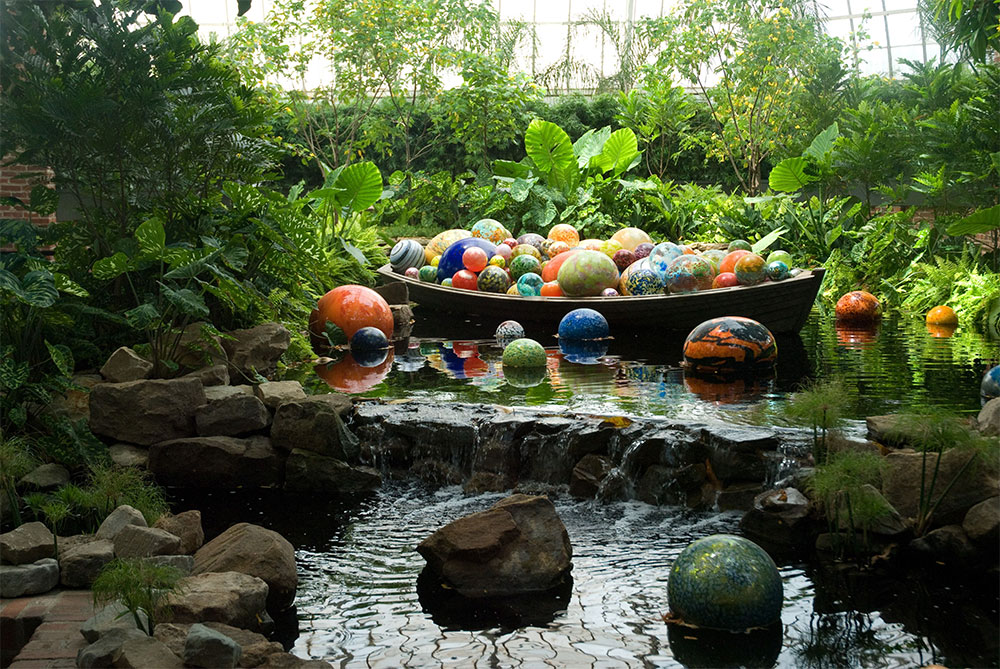
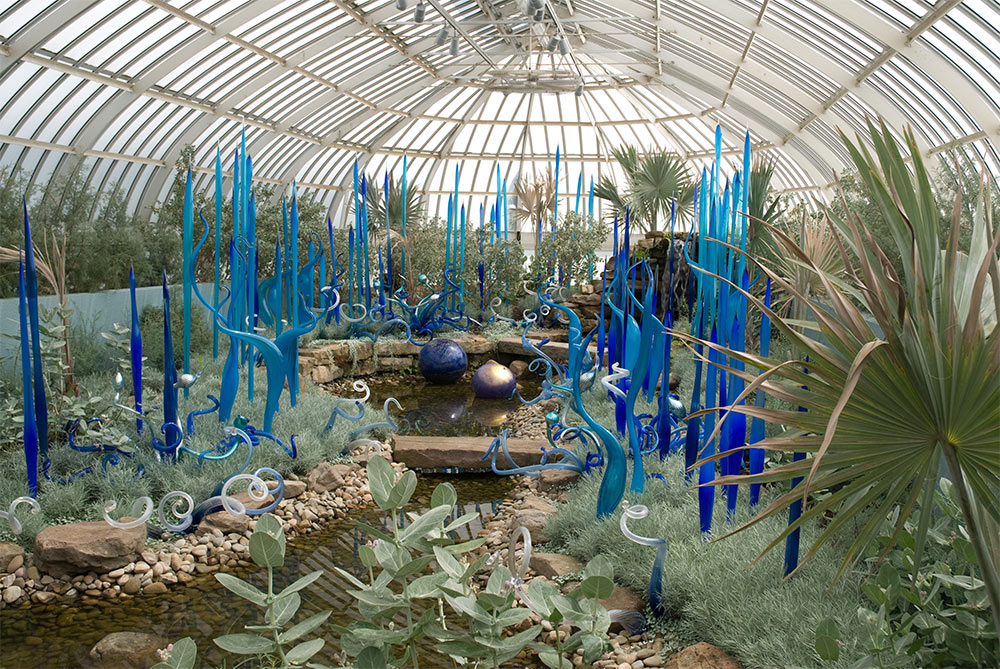
After the landmark Chihuly exhibit concluded at the Conservatory in 2008, Phipps turned its attention back to green buildings and decided to take on one of its greatest challenges to date: designing a Living Building. The Center for Sustainable Landscapes (or CSL) was planned to function as the administrative office for Phipps’ growing staff. It would also feature a large classroom for school programs at the Conservatory, and educational elements for visitors, such as biophilic art installations and a rooftop garden planted with local medicinal foliage.
2009 brought another glass artist collaboration to Phipps with the exhibit Life in the Gardens, featuring more than 185 sculptures by German artist Hans Godo Fräbel. Fräbel — who created the famous and seemingly extraterrestrial “Longfellows” that are currently displayed in the Orchid Room — provided new installations and old for the exhibit. “My team and I created several new installations,” he explained, “such as the ‘Longfellow Gravity,’ an installation consisting of three large cubes that seem to function as a playground for a dozen Longfellows.”143 The whimsical exhibit remained on display through Jan. 20, 2010.81
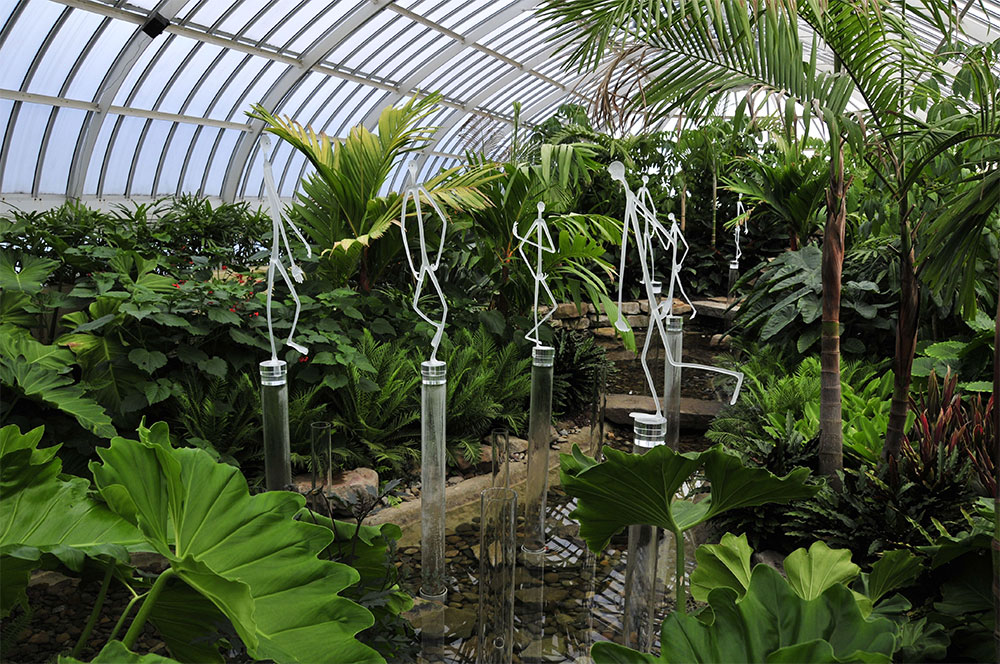
In 2011, Phipps launched an initiative to further our mission to promote human and environmental well-being through action and research: Let’s Move Pittsburgh (LMP). This comprehensive healthy lifestyles program incorporates and empowers local organizations, healthcare providers, educators, and parents and caregivers to promote healthy diets and routines for children. LMP uses many avenues to give local children access to health-based knowledge and events, such as free monthly family fitness classes, annual mini-grants for Champion Schools, speaking engagements, the Green Light Foods nutrition assessment app and more. The program empowers parents and caregivers to teach children best practices by providing simple and healthy recipes, fun fitness activities, and educational games and resources. Later, LMP would also adapt the 5-2-1-0 initiative created by Let's Go! The message of 5-2-1-0 encourages children to eat five or more servings of fruits and vegetables, two hours or less of recreational screen time, one hour or more of physical activity, and zero sugary drinks and more water every day.82
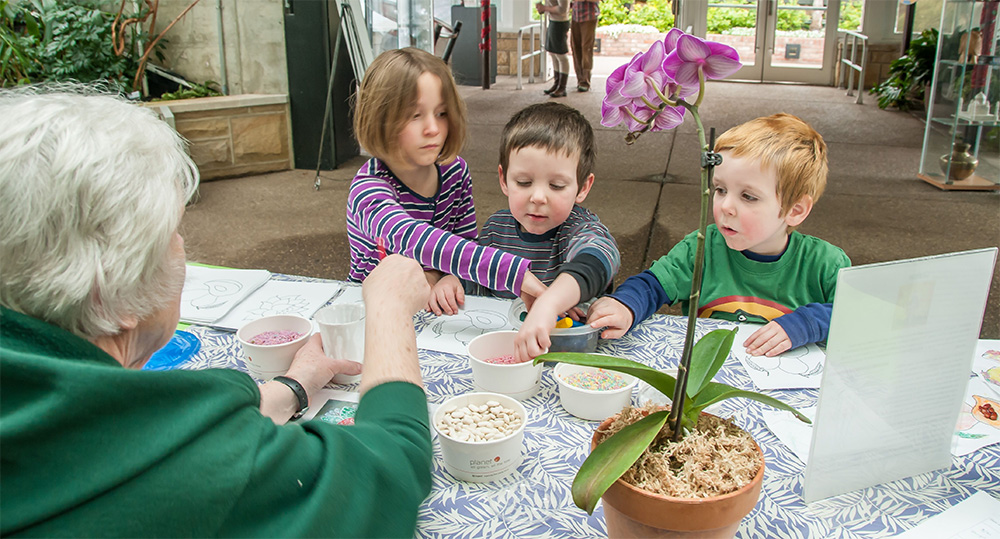
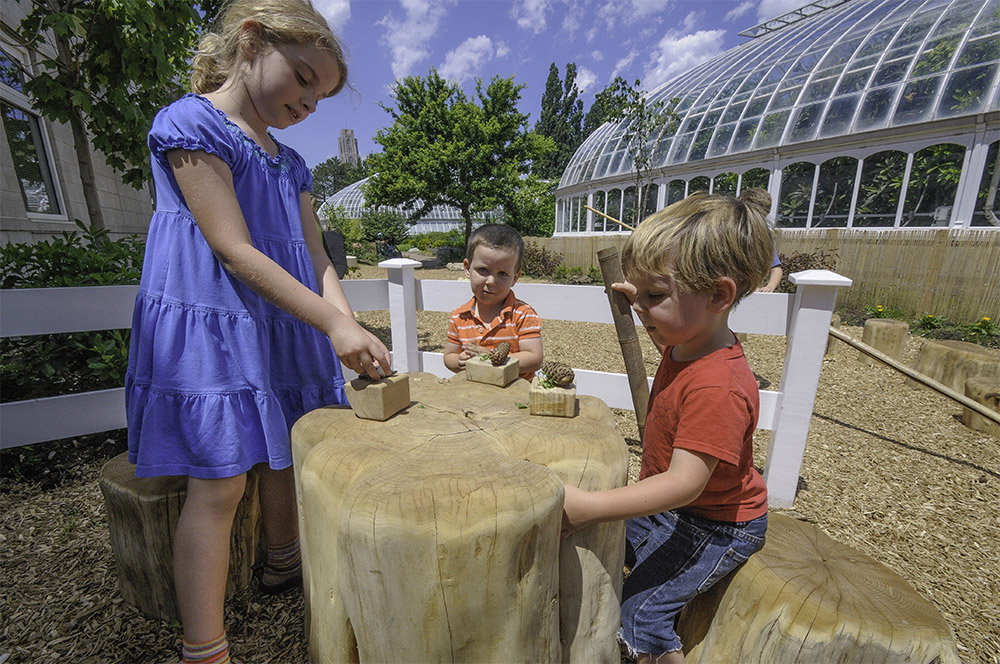
After years of design and construction, the Center for Sustainable Landscapes opened on Dec. 5, 2012 and revolutionized the concept of sustainable architecture. The sleek and aesthetically-pleasing office building leads by example as an environmental education center. It features 14 geothermal wells for heating and cooling, passively heated and cooled atriums, solar and wind power generation, a lagoon system to manage rainwater, constructed wetlands to treat sanitary water, rainwater harvesting and reuse, permeable paving, and many other state-of-the-art sustainable innovations. The CSL remains the first and only building in the world to meet seven of the highest sustainable building standards: LEED® Platinum (Leadership in Energy and Environmental Design), SITES Platinum, WELL Building Platinum, Net-Zero Energy, Fitwel 3 Star, BREEAM Outstanding In-Use and Living Building Challenge. Green Building Alliance Director of Innovation Aurora Sharrard commended the vision behind the integrated building design: “Phipps is publicly demonstrating why it’s important to consider certain choices that we make. They’re not just walking the walk. They’re showing the path.”80 Massaro Corporation oversaw construction and the Downtown Pittsburgh Design Alliance designed the CSL, with contributions from the following sustainability-focused organizations: Green Building Alliance, Carnegie Mellon University’s Center for Building Performance and Diagnostics, the University of Pittsburgh’s Mascaro Center for Sustainable Innovation, Chatham University and Duquesne University.80
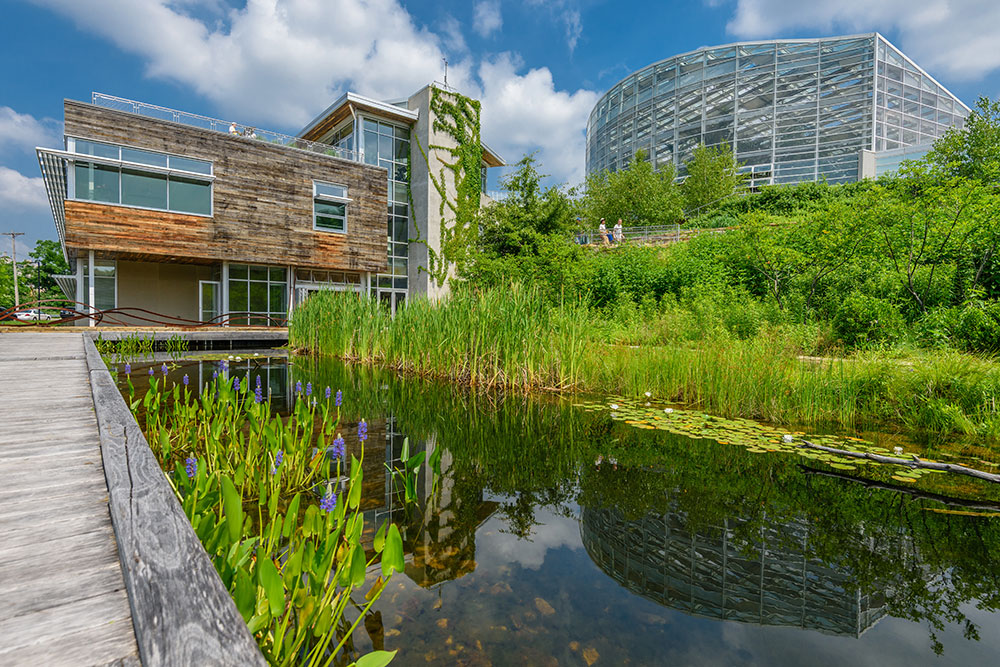
Phipps' administrative, education and research staff who work in the CSL are also encouraged and empowered to “walk the walk” to live healthier and closer to nature. The CSL is a clean air environment and makes use of natural lighting and ventilation as much as possible; air-cleaning plants such as orchids and pothos abound throughout the offices and are maintained by horticulture staff; artwork and natural soundscapes in the atriums allow staff to reflect upon the connections between themselves, art and nature; a Wellness Library open to staff offers educational books and videos for improved wellbeing; stairways and gently inclining paths on the outdoor terrace provide alternative travel to the energy-efficient elevator; the rainwater lagoon also serves as a natural attraction for visitors and local wildlife; and abundant windows in the offices provide sunlight and a sweeping view of Panther Hollow.83,84
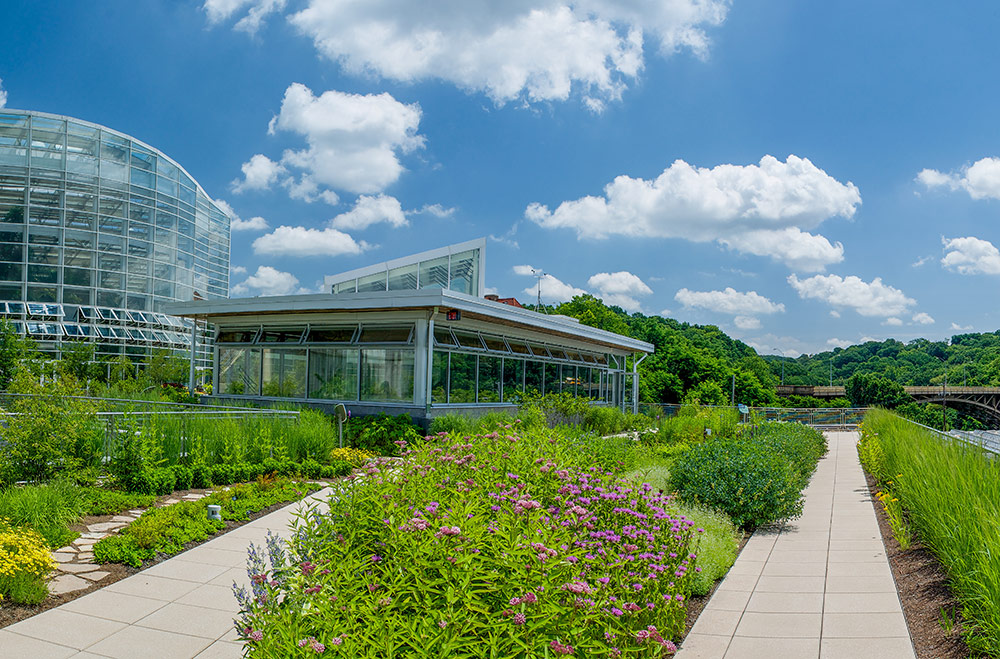
2012 also proved a landmark year for Phipps' developing flower show exhibits. Tropical Forest India debuted, display including a temple façade, healing plants used in Ayurvedic medicine, endemic plants and cultural artifacts.85 Later in 2012, Winter Flower Show opened with a new feature that has become a highly anticipated annual attraction: the Winter Light Garden. This colorful display of lights in the Children's Discovery Garden and Outdoor Garden grows with new features added each year.
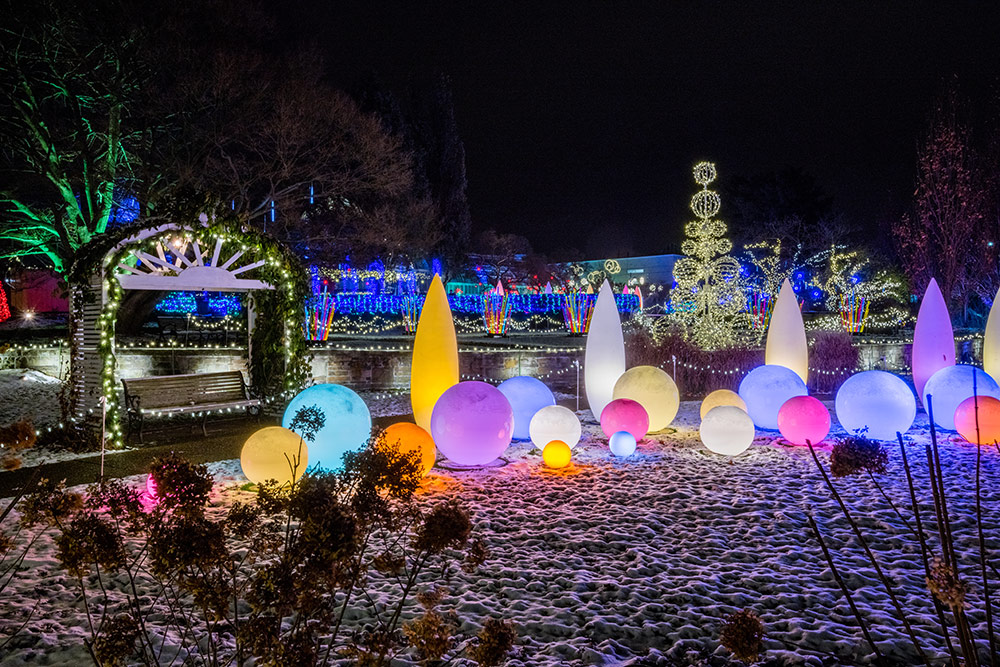
Phipps' extended its impact beyond our glass walls in 2013 with the launch of the Homegrown program. Homegrown is dedicated to increasing access to fresh produce in underserved Pittsburgh communities that are considered to be food deserts, or places where access to fresh food is scarce. Phipps staff install raised bed vegetable gardens in the backyards of each participant and equip them with the tools and skills they need to grow their own fresh fruits, vegetables and herbs. This program also uses outreach efforts to promote better food choices with the goal of improving the overall health of local families. The program started in the Homewood neighborhood, and has since expanded to Lincoln-Lemington-Belmar, Larimer and the East Hills. In Homewood alone, this program installed gardens in almost one in every 10 households. Participants enrolled in Homegrown commit to two years of involvement as well as attending monthly classes and tending the gardens as able.86
In August 2013, record-breaking crowds rushed into Phipps over a period of 48 hours just to smell a flower. The corpse flower has a notoriously brief and pungent bloom, and Phipps was home to “Romero,” a specimen named after Pittsburgh-native filmmaker known for Night of the Living Dead. The Conservatory remained open until 2 a.m. to accommodate curious guests as much as possible during this unique bloom; more than 12,000 visitors in a single day broke previous attendance records as visitors gathered to see —and smell — this rare phenomenon.87,88 Romero unexpectedly bloomed again three years later, and Phipps’ second corpse flower specimen, “Barbara,” bloomed in 2017.
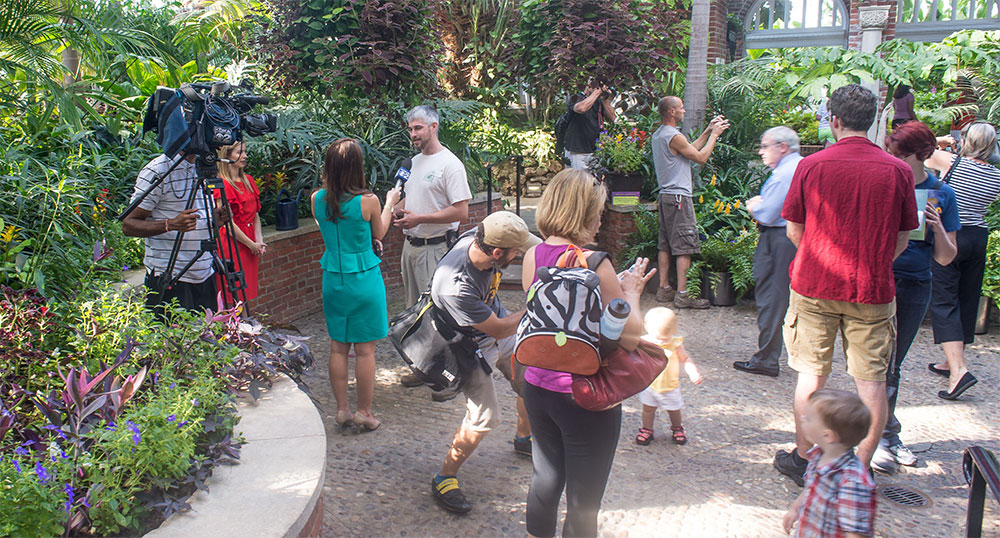
Since 2005, Café Phipps had been serving organic and locally-sourced meals and refining its sustainability practices to receive a 3-star green restaurant certification. This hard work and dedication was recognized in 2014 when the café was named one of the Best Museum Restaurants in the U.S. by Food & Wine89 magazine.
The next green building at Phipps debuted in 2015 with the opening of the Nature Lab at Phipps. This classroom was among the nation’s first sustainable, modular learning spaces. It exemplifies a healthy and environmentally responsible children’s classroom through its design and functions, while operating as a learning laboratory and an on-site venue for children’s programs at Phipps. The Nature Lab achieved Living Building Petal Certification in the categories of Site, Water, Energy, Equity and Beauty in May 2017 from the International Living Future Institute.90
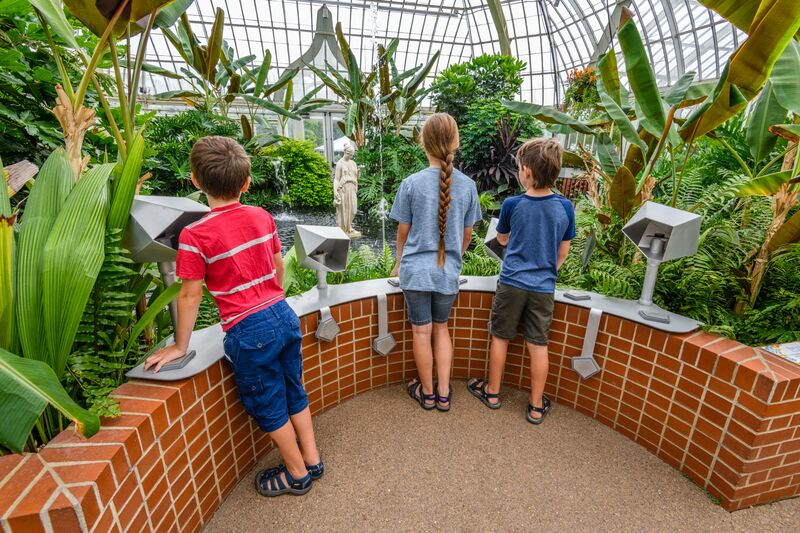
In 2016, Phipps' popular Garden Railroad joined the City of Pittsburgh in celebrating the city’s bicentennial anniversary by presenting “200 Years of Pittsburgh.” The intricate, popular display featured an interactive Duquesne Incline and other historic Pittsburgh landmarks, such as Three Rivers Stadium, Forbes Field, the Cathedral of Learning and more.91
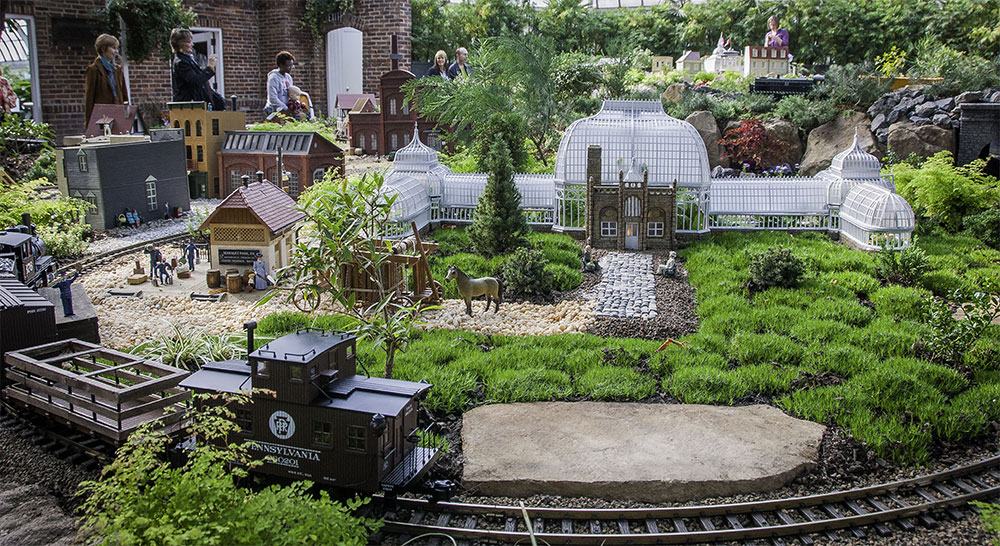
Phipps' dedication to demonstrating the important interconnection of human and environmental health took its next significant step forward as we hosted the first One Health One PlanetTM Symposium in April 2017. This landmark event brought together scientists, professionals within the public and animal health fields, ecologists, architecture and green building professionals, and community leaders within education and civil services. This annual symposium explores different facets of the interconnectedness of environmental, human and animal health; themes in subsequent years have included Chemicals of Concern in the Environment and the Future of Food.92
On May 6, 2017, 10 years after the record-breaking Chihuly glass exhibit, Phipps displayed SUPER. NATURAL. Glass Art by Jason Gamrath, an exhibit featuring more than 40 installations of supersized glass plants. Glass orchids, Venus flytraps and many more colorful flowers and plants complemented real-life specimens throughout the glasshouses. The artwork stood between 6 – 14 feet tall, and many of the pieces were custom made for this exhibit. Two pieces remain at Phipps today as permanent installations, including blue pitcher plants in the Fern Room and a vibrant orange orchid in the Stove Room. “SUPER. NATURAL.” ran for a combined six-month Summer and Fall Flower Show, with the pieces seamlessly integrating with a new, autumnal plant palette as the seasons changed.93
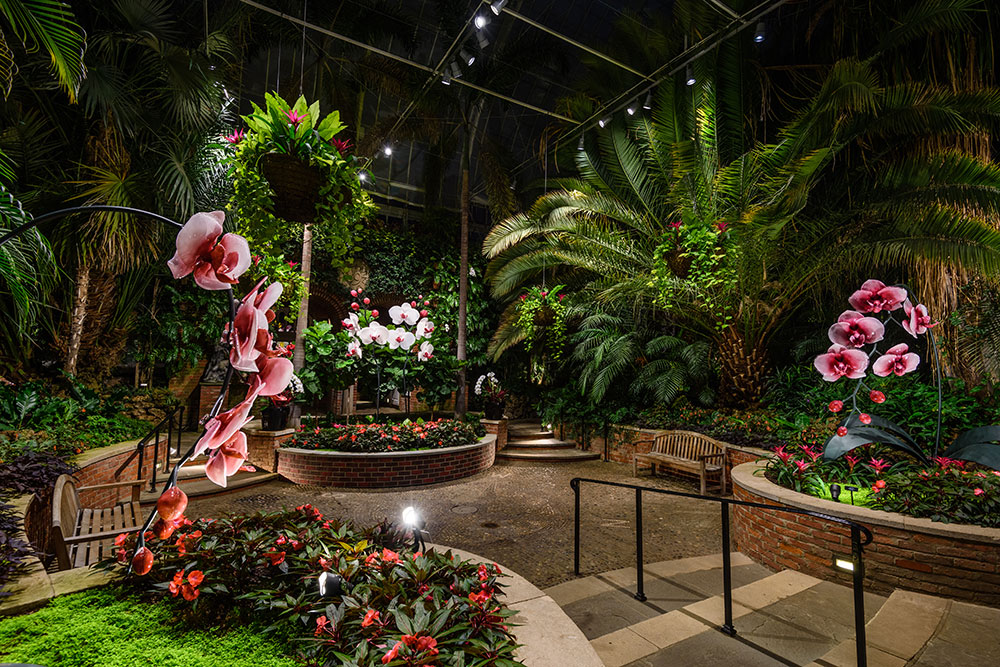
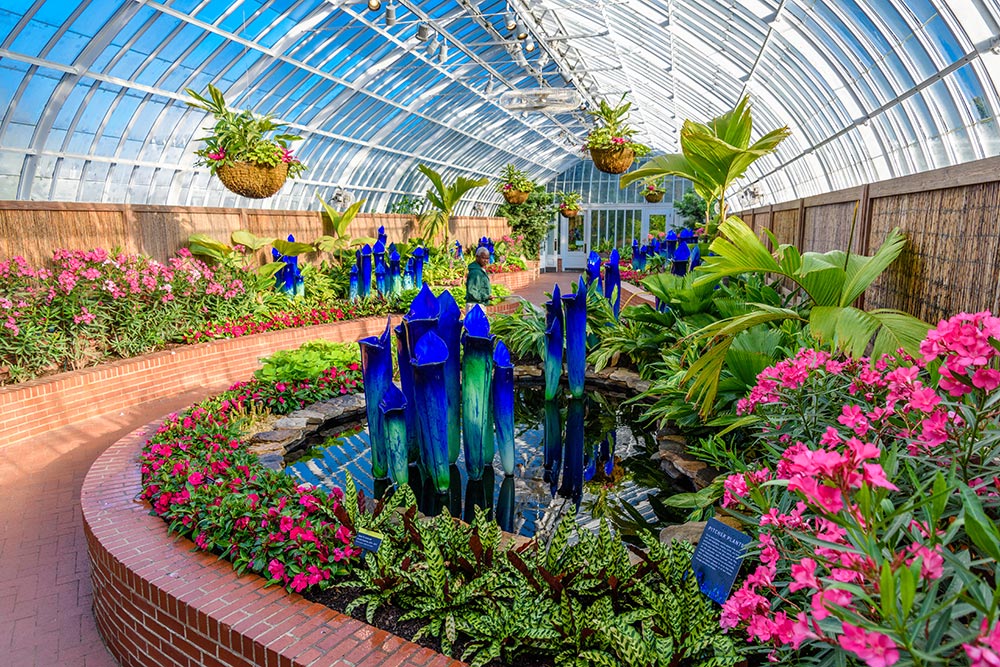
In 2018, Phipps celebrated our 125th anniversary with a pane-by-pane restoration of the Palm Court glass roof, including the return of the original ogee crest for the first time since it was torn away by a storm in 1937. Guests were invited to sponsor a pane of glass, and received certificates and recognition in the Conservatory for donating to this historic restoration.94 Other 125th anniversary celebrations included an activity-filled autumn gala and Fall Flower Show: 125 Years of Wonder.
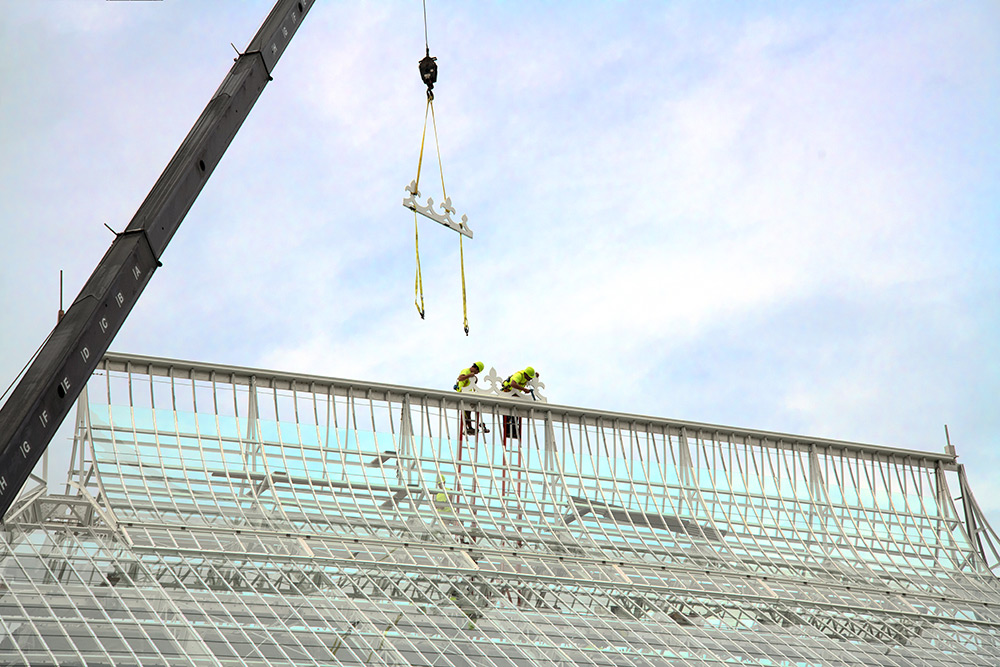
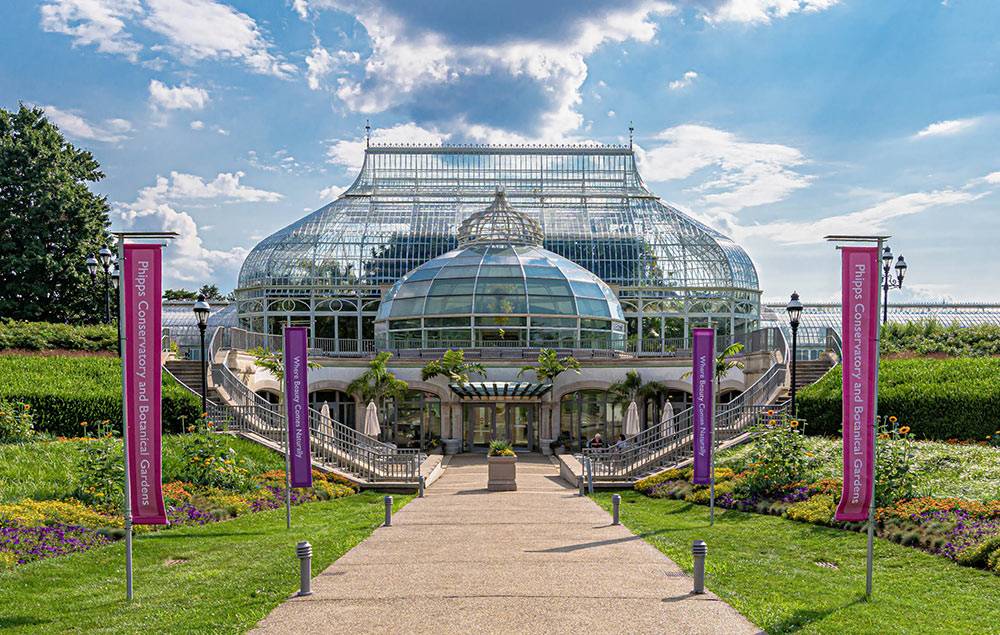
In the spring of 2019, Phipps Conservatory opened the latest — and perhaps most unexpected — green building on our campus: The Exhibit Staging Center (ESC). Formerly a City of Pittsburgh public works building, Phipps renovated this rundown facility into one of groundbreaking facility, with a focus on the health and well-being of the facilities staff who use the building. The ESC features a dedicated space for prop creation and storage, as well a fitness center, indoor and outdoor yoga studio and a meditation room for employees. The ESC is designed to achieve three of the most rigorous building standards in the world: LEED Platinum, WELL Platinum and Living Building Challenge certifications. The ESC opened on May 15, 2019 with a grand celebration — the Big Green Block Party, which featured an entirely vegan and vegetarian menu, locally and sustainably sourced food and drink, a ribbon cutting ceremony and live entertainment. Today, the building vestibule is open to visitors with views of the prop storage construction area and exhibit archives.95 Upon successful completion of the Living Building Challenge’s one-year performance period in 2023, Phipps had three Living and Petal Certified Buildings on its site, each showcasing a different construction type: new (CSL), modular (Nature Lab) and existing (ESC).
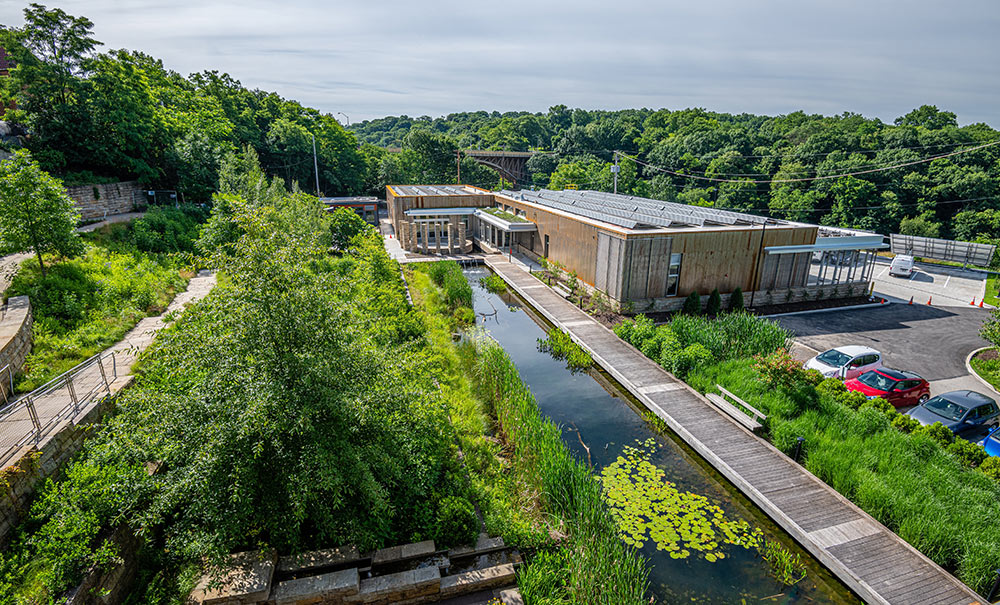
The ongoing story of Phipps Conservatory can perhaps best be summarized by the treasured memories of guests who have visited across generations, such as the family of former Board of Trustees member Mernie Berger, who first visited in the late 1920s. "I love the intimate presence that Phipps has provided in my lifetime as well as my family’s life," Berger says. "As a child, my parents brought me to the Conservatory. In return, I have brought my children to Phipps, I have brought my grandchildren to Phipps, and now I even bring my great-grandchildren to Phipps to explore its wonders.96
Citations
69. “Phipps Has Growing Pains; Group to Take Over Conservatory.” The Pittsburgh Post-Gazette 66 no. 29 (1993): 19, 24. Newspapers.com.
70. Curt Pesanka, interview by Kaitlin Green, April 6, 2020, recording.
71. “Blooming Treasure.” The Pittsburgh Post-Gazette 67 no. 125 (1993): 65. Newspapers.com.
72. “Putting Down Roots at Phipps.” The Pittsburgh Post-Gazette 67 no. 355 (1994):25. Newspapers.com.
73. “Oakland – Education at Phipps.” The Pittsburgh Post-Gazette 69 no. 14 (1995): 9. Newspapers.com.
74. “Discovery Garden Grand Opening Festival.” The Pittsburgh Post-Gazette 69 no. 347 (1996): 72. Newspapers.com.
75. “A Green Escape at a New Phipps.” The Pittsburgh Post-Gazette 74 no. 279 (2001): 32. Newspapers.com.
76. Margie Radebaugh, interview by Kaitlin Green, April 10, 2020, recording.
77. “Phipps Conservatory Expands.” The Indiana Gazette 101 no. 284 (2005): 3. Newspapers.com.
78. “Cool Chihuly.” The Pittsburgh Post-Gazette 80 no. 285 (2007): 31. Newspapers.com.
79. “Chihuly at Phipps: Gardens and Glass.” Phipps Conservatory and Botanical Gardens. Accessed April 16, 2020.
80. “Inside Phipps’ Center for Sustainable Landscapes: Making Clean Water, All in One Place.” The Pittsburgh Post-Gazette 85 no. 98 (2011): 93. Newspapers.com.
81. “Fragile Phipps.” The Pittsburgh Post-Gazette 82 no. 294 (2009): 52. Newspapers.com.
82. Let’s Move Pittsburgh.” Phipps Conservatory and Botanical Gardens. Accessed April 15, 2020. https://www.phipps.conservatory.org/lets-move-pittsburgh.
83. “Growing Green.” The Pittsburgh Post-Gazette 85 no. 134 (2011): 26. Newspapers.com.
84. “Going Green from the Inside Out.” The Pittsburgh Post-Gazette 87 no. 11 (2013): 21. Newspapers.com.
85. “Tropical Forest India to Open at Phipps.” The Pittsburgh Post-Gazette 85 no. 181 (2012): 30. Newspapers.com.
86. “Homegrown.” Phipps Conservatory and Botanical Gardens. Accessed April 15, 2020. https://www.phipps.conservatory.org/classes-and-programs/for-communities/homegrown.
87. “A Corpse Would Smell as Sweet.” The Pittsburgh Post-Gazette 87 no. 10 (2013): 1. Newspapers.com.
88. “Romero the Corpse Flower Blooms.” Phipps 2010 Decade in Review. Phipps Conservatory and Botanical Gardens. Accessed April 16, 2020. https://www.phipps.conservatory.org/blog/detail/phipps-2010-decade-in-review.
89. “Museum Food Can Be A Work of Art.” The Pittsburgh Post-Gazette 87 no. 319 (2014): 76. Newspapers.com.
90. “The Nature Lab at Phipps Opens.” Phipps 2010 Decade in Review. Phipps Conservatory and Botanical Gardens. Accessed April 16, 2020. https://www.phipps.conservatory.org/blog/detail/phipps-2010-decade-in-review.
91. “Garden Railroad: 200 Years of Pittsburgh.” Phipps 2010 Decade in Review. Phipps Conservatory and Botanical Gardens. Accessed April 16, 2020.https://www.phipps.conservatory.org/blog/detail/phipps-2010-decade-in-review.
92. “One Health One PlanetTM.” Phipps Conservatory and Botanical Gardens. Accessed April 17, 2020. https://www.phipps.conservatory.org/green-innovation/for-the-world/one-health-one-planet.
93. “SUPER. NATURAL. Glass Art by Jason Gamrath” Phipps 2010 Decade in Review. Phipps Conservatory and Botanical Gardens. Accessed April 17, 2020. https://www.phipps.conservatory.org/blog/detail/phipps-2010-decade-in-review.
94. “Become a Part of Phipps History – Sponsor a Glass Pane Today!” Phipps Conservatory and Botanical Gardens. Accessed April 17, 2020. https://www.restore.conservatory.org/#s1.
95. “Exhibit Staging Center.” Phipps Conservatory and Botanical Gardens. Accessed April 17, 2020. https://www.phipps.conservatory.org/green-innovation/at-phipps/exhibit-staging-center.
96. Mernie Berger, interview by Kim Vo, February 24, 2012, transcript.


